The Himalayas are an ancient mountain range that spans several countries in South Asia, including India, Nepal, and Bhutan. It is home to a large variety of birds, many of which are endemic to the region.
Birds of the Himalayas come in a wide range of colors, sizes, and species, from the graceful and colorful pheasants to the majestic Lammergeyers. These birds are a sight to behold, and they offer a unique glimpse into the beauty of this region.
With its diverse habitats, the Himalayas is a haven for birdwatchers, providing a plentiful variety of species to observe and appreciate.
1. Himalayan Black-lored Tit
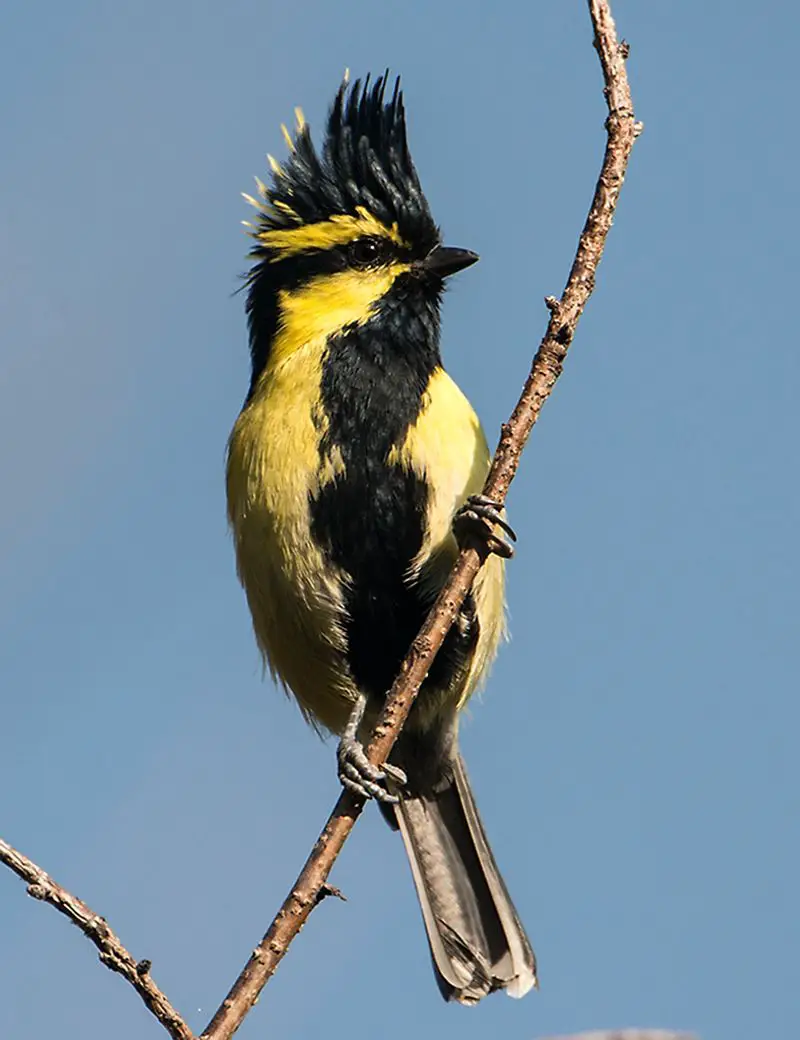
The Himalayan Black-lored Tit (Paridae) is a small passerine bird that is found primarily in the Himalayan region. It is easily identifiable by its black lores, which are the patches of feathers on the sides of its head.
This species is closely related to the Yellow-cheeked Tit, with the two species likely having a common ancestor. This is evident in their similar physical features and behavior.
The Himalayan Black-lored Tit has yellow cheeks and a black forehead, while the Yellow-cheeked Tit has yellow cheeks and a yellow forehead. They also share similar diets of mostly insects and larvae.
In addition, both species occupy similar habitats, such as woodlands, forest edges, and shrublands. The two species are known to coexist in some areas, such as in the Indian Subcontinent.
However, the Himalayan Black-lored Tit is more widely distributed and can be found in parts of China, Nepal, and Bhutan.
| Kingdom | Animalia |
| Phylum | Chordata |
| Class | Aves |
| Order | Passeriformes |
| Family | Paridae |
| Genus | Machlolophus |
| Species | M. xanthogenys |
2. Himalayan Monal
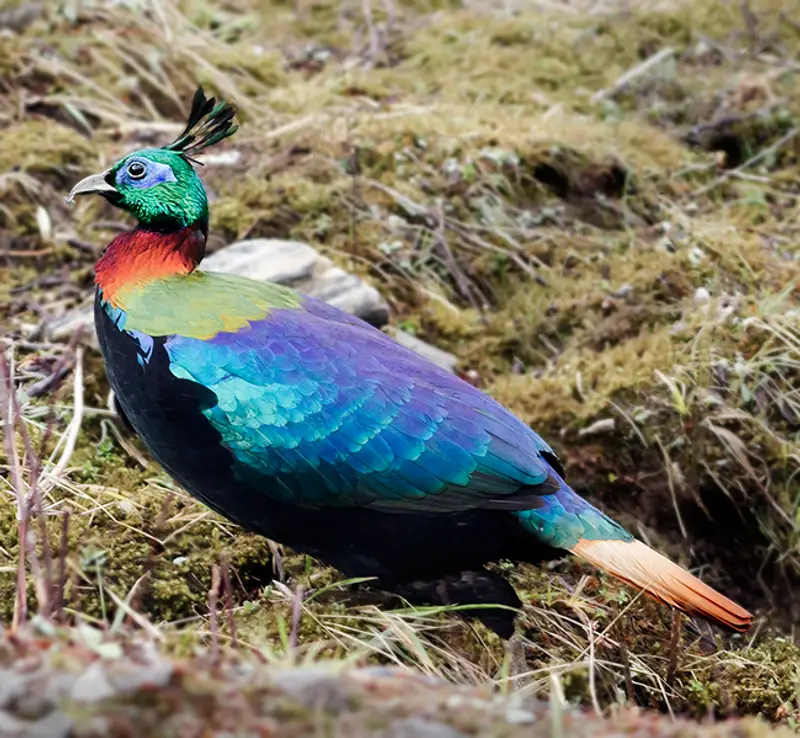
The Himalayan monal is a pheasant native to the mountainous regions of the Himalayas. It is also known as the Impeyan monal or Impeyan pheasant. It is found in forest and shrubland areas located at elevations between 2,100 and 4,500 meters above sea level.
It is part of the family Phasianidae, which are all birds found in the pheasant family. The Himalayan monal is listed as a species of Least Concern on the IUCN Red List.
This means that the species is not currently threatened with extinction, although it is still vulnerable and its population numbers should be monitored. The Himalayan monal is a beautiful bird, with colorful plumage ranging from blue to green to red.
It also has a distinctively long tail and a loud call. The Himalayan monal is an important species in the Himalayan ecosystem, as it helps to maintain healthy forests and shrublands.
It also provides food for a variety of predators in the region, including raptors, foxes, and even snow leopards.
| Kingdom | Animalia |
| Phylum | Chordata |
| Class | Aves |
| Order | Galliformes |
| Family | Phasianidae |
| Genus | Lophophorus |
| Species | L. impejanus |
3. Himalayan Woodpecker
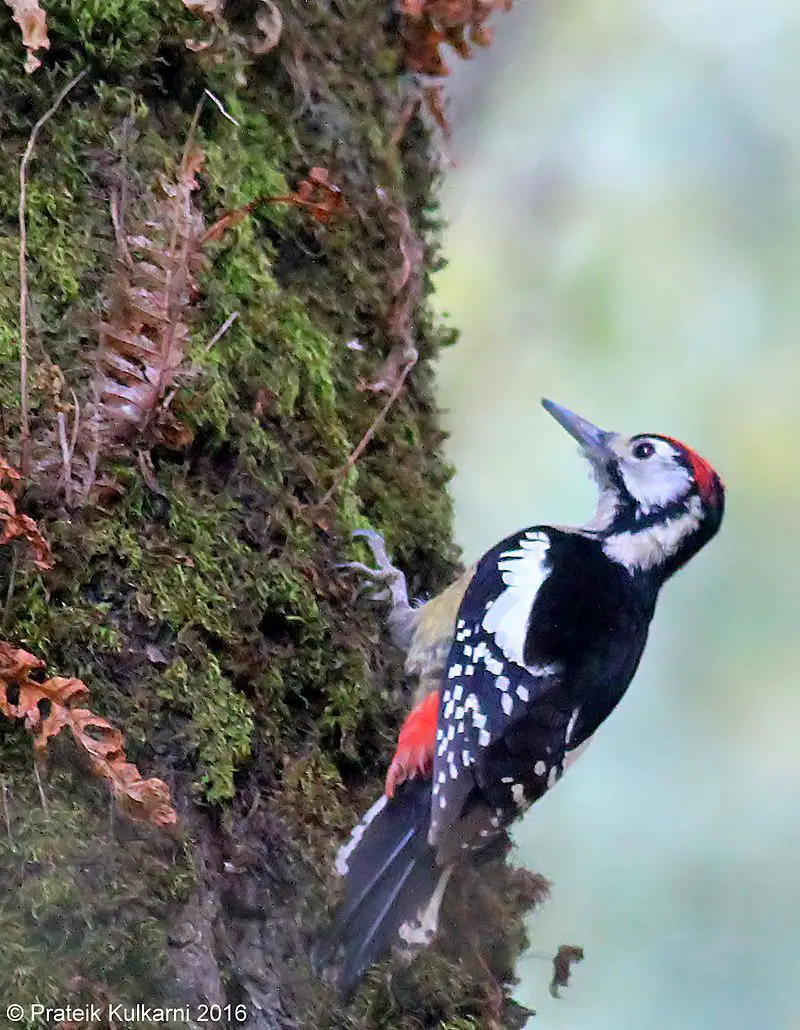
The Himalayan woodpecker is an impressive species of bird that is found in the northern regions of the Indian subcontinent. These regions include the Himalayas and some adjoining areas, such as Afghanistan, India, Nepal, Bhutan, and Pakistan.
This bird is easily recognizable by its black feathers that contrast with the white feathers on its head and neck. The Himalayan woodpecker is also unique in that its habitat is not limited to one specific type of forest.
Instead, it is found in both boreal and temperate forests. Boreal forests are cold and have coniferous trees, while temperate forests are warm and have both deciduous and coniferous trees.
The Himalayan woodpecker is able to adapt to the different climates and vegetation in these forests, making it a unique and remarkable bird.
| Kingdom | Animalia |
| Phylum | Chordata |
| Class | Aves |
| Order | Piciformes |
| Family | Picidae |
| Genus | Dendrocopos |
| Species | D. himalayensis |
4. Grey-hooded Warbler
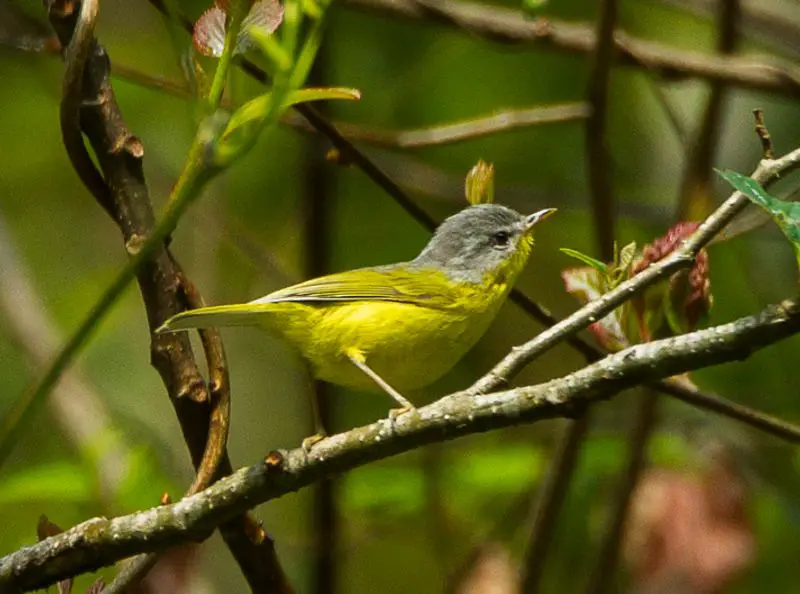
The grey-hooded warbler is a species of leaf warbler, known for its distinctive song. Its scientific name is Phylloscopus xanthoschistos, and it is part of the “Old World warbler” family.
This bird can be found in the Himalayas, the mountain range that runs across the northern part of India, Nepal, Bhutan, and China. It prefers temperate forests, where it can find plenty of vegetation to feed on and shelter from the elements.
The grey-hooded warbler is a small bird, about 10-12 cm in length. It has a grey hood, streaked with lighter shades of grey and brown, and a bright yellow underside.
Its diet consists mainly of small insects and other invertebrates, which it finds in the thick vegetation of its habitat. The warbler is a common sight in the Himalayas and is often seen perching on branches or foliage in search of food.
Its song is a melodious warble, which is often heard in the early morning and late evening. This species is not considered to be threatened, but its population is decreasing due to habitat loss.
It is important to protect the natural environment of the grey-hooded warbler, as well as other bird species, to ensure their continued survival.
| Kingdom | Animalia |
| Phylum | Chordata |
| Class | Aves |
| Order | Passeriformes |
| Family | Phylloscopidae |
| Genus | Phylloscopus |
| Species | P. xanthoschistos |
5. Himalayan Vulture
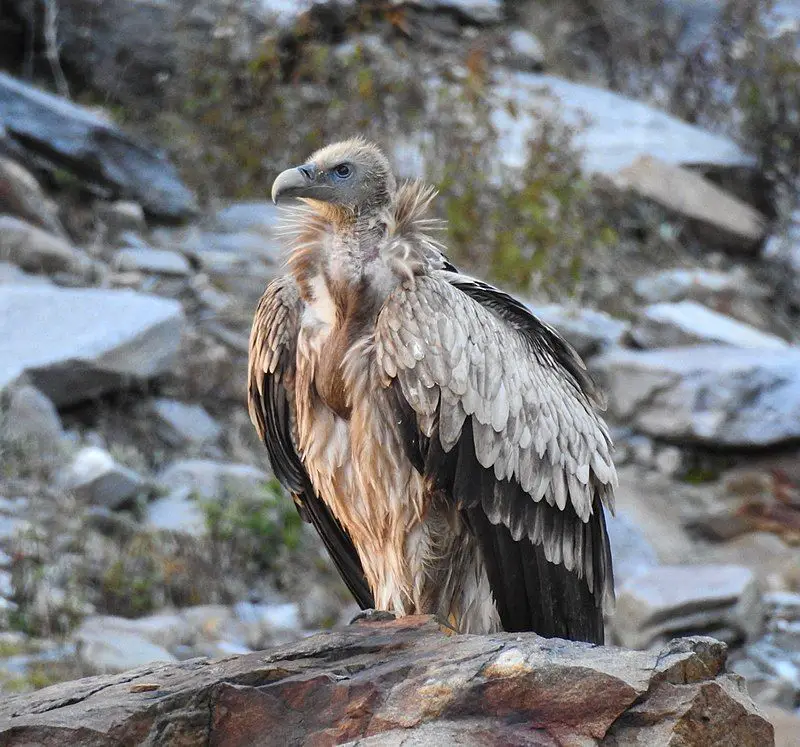
The Himalayan vulture, also known as the Himalayan griffon vulture, is an Old World species of vulture native to the Himalayas and the neighboring Tibetan Plateau.
This particular species of vulture is one of the two largest Old World vultures and can accurately be classified as a true raptor. Unfortunately, the current population of this species has declined so drastically that it has been listed as Near Threatened on the IUCN Red List.
This species of vulture is found primarily in the mountainous regions of the Himalayas, where it prefers to live in open woodlands and grasslands. The Himalayan vulture is a large bird, with a wingspan of up to 2.5 meters and a body length of up to 1 meter.
It has a predominantly dark brown plumage, with white patches on the wings and tail. Its bill is large and powerful, and its legs are mostly covered in feathers. The Himalayan vulture is an opportunistic scavenger that feeds mainly on carrion.
It is commonly seen soaring in the sky, searching for food. It also feeds on eggs, small mammals, and reptiles, as well as occasionally preying on young domestic livestock.
It has been observed to hunt in pairs, with one bird flushing out prey while the other waits for it to be caught. This species of vulture is listed as Near Threatened on the IUCN Red List due to a dramatic decline in its population in recent years.
This decline is mostly attributed to hunting and poisoning, as well as loss of habitat due to deforestation. In addition, the use of diclofenac in livestock has caused a decline in the vulture’s food source, further exacerbating the problem.
Conservation efforts are being made to help protect the species, but its future is uncertain.
| Kingdom | Animalia |
| Phylum | Chordata |
| Class | Aves |
| Order | Accipitriformes |
| Family | Accipitridae |
| Genus | Gyps |
| Species | G. himalayensis |
6. Grey-winged Blackbird
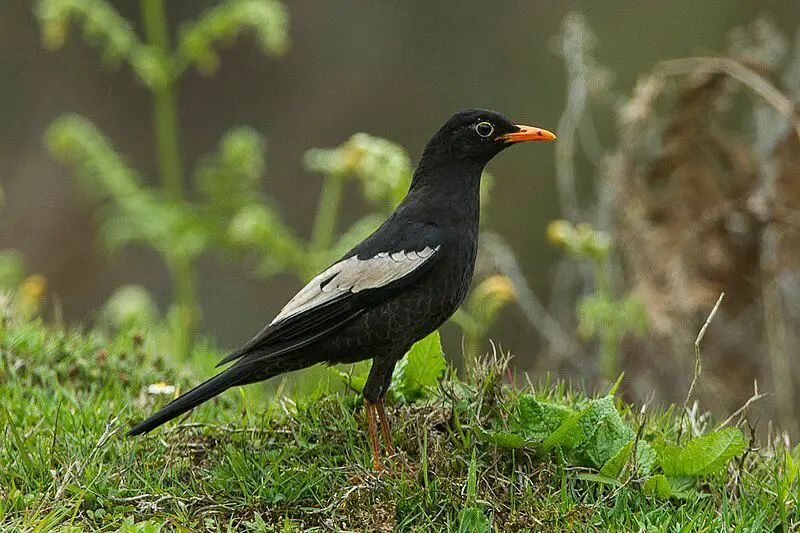
The grey-winged blackbird is a species of bird belonging to the thrush family. It is native to south-eastern Asia, ranging from the Himalayas to northern Vietnam.
This species prefers to inhabit subtropical or tropical moist montane forests, which are forests situated in mountainous areas that are characterized by high levels of humidity and rainfall.
The grey-winged blackbird is an important part of its natural habitat, as it helps to keep the insect population in check. Additionally, its presence helps to disperse the seeds of certain plants, which in turn helps to promote the growth of new vegetation.
It also provides important sources of food for other animals, such as small mammals and reptiles. The grey-winged blackbird is an important part of the natural ecosystem in its range, and its conservation is essential in order to maintain a healthy biodiversity in the region.
| Kingdom | Animalia |
| Phylum | Chordata |
| Class | Aves |
| Order | Passeriformes |
| Family | Turdidae |
| Genus | Turdus |
| Species | T. boulboul |
7. Monal
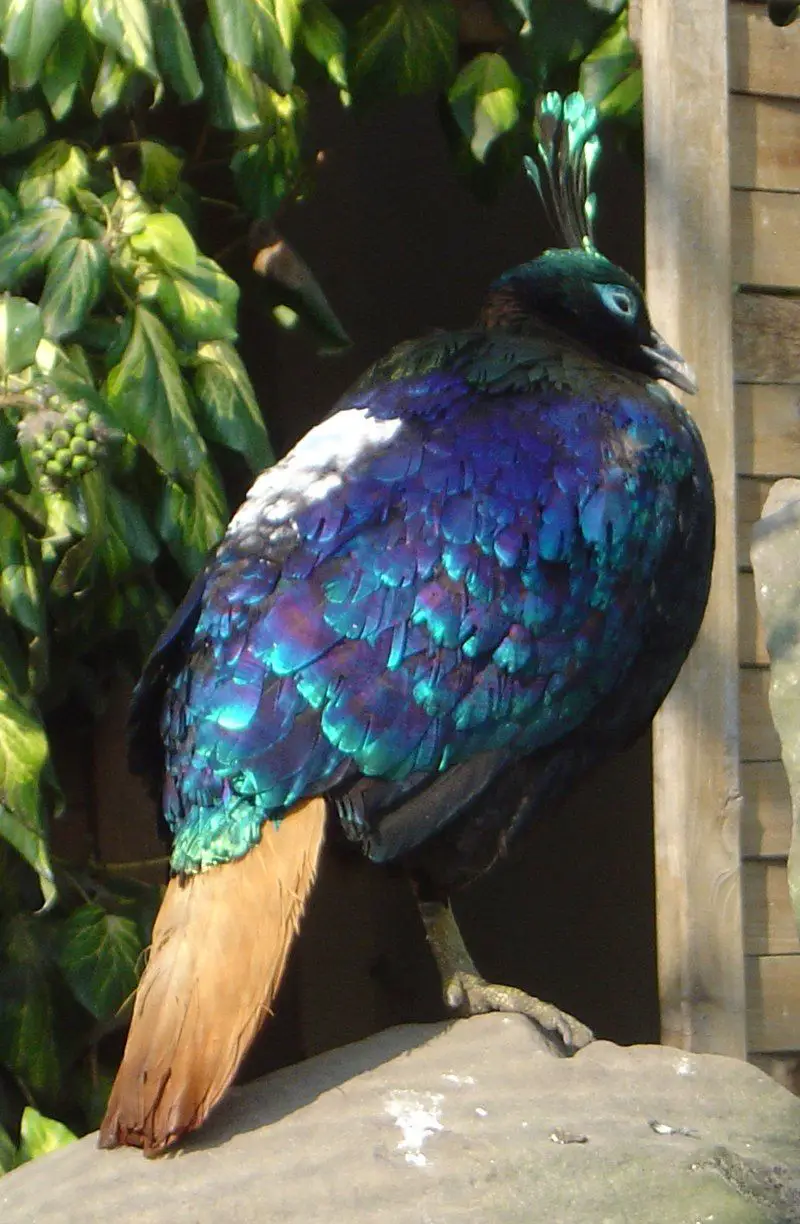
The monal is a species of bird that belongs to the pheasant family, Phasianidae. It is a type of game bird that is native to the Himalayan region of South Asia. It is also known as the Impeyan pheasant, Himalayan monal, or the Impeyan monal.
This species is the national bird of Nepal, and its scientific name is Lophophorus. It is a medium-sized bird, with males being up to 45 cm long and females being up to 37 cm long. The males have a colorful crest and metallic-green plumage, while the females are a duller brown.
The monal has a loud, metallic call that can be heard from far away, and it is quite a sight when the males are displaying their colorful plumage. These birds inhabit the high altitude forests, and they prefer to stay in pairs or small groups.
They feed on leaves, insects, and small fruits. Monals are considered an important game bird, and they are hunted for their meat and eggs.
| Kingdom | Animalia |
| Phylum | Chordata |
| Class | Aves |
| Order | Galliformes |
| Family | Phasianidae |
| Genus | Lophophorus |
8. Himalayan White-browed Rosefinch
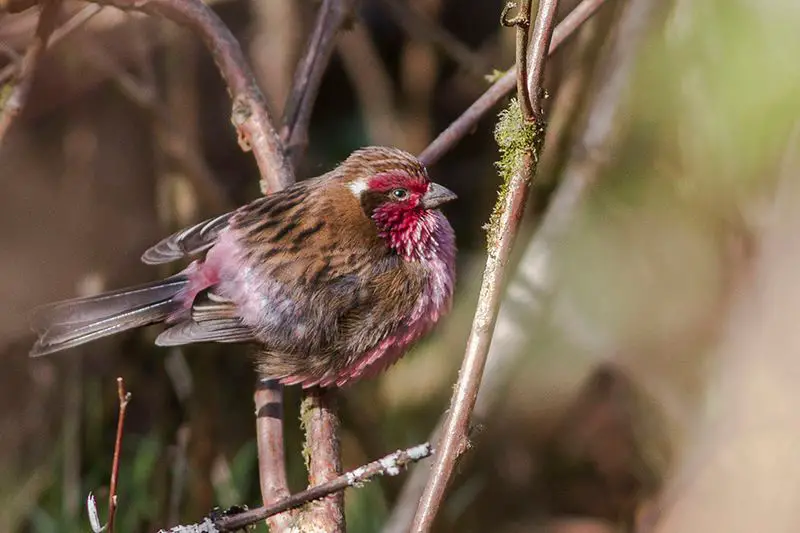
The Himalayan white-browed rosefinch is a species of finch that is native to the Himalayas region. It is found across a vast area, stretching from Afghanistan in the west, to India, Tibet, Bhutan and Nepal in the east.
This species is primarily found in temperate forests and temperate shrubland habitats, where it can find food, shelter, and nest.
These habitats are characterized by moderate temperatures, ample precipitation, and diverse vegetation, which provides a suitable habitat for the rosefinch. The species is also known to visit gardens and other human-altered landscapes during its seasonal migrations.
It is a gregarious species, meaning it lives in large flocks, foraging for seeds and other food sources in the surrounding vegetation. The white-browed rosefinch is a small bird, with a length of around 11-13 centimeters and a wingspan of around 21-26 centimeters.
It has a distinctive white brow and a bright pinkish-red body, with a black tail and wings.
The Himalayan white-browed rosefinch is an important species in the Himalayan region, as it plays a vital role in the local ecosystem, being a part of the food chain and dispersing seeds in the process of foraging.
| Kingdom | Animalia |
| Phylum | Chordata |
| Class | Aves |
| Order | Passeriformes |
| Family | Fringillidae |
| Genus | Carpodacus |
| Species | C. thura |
9. Blue-fronted Redstart
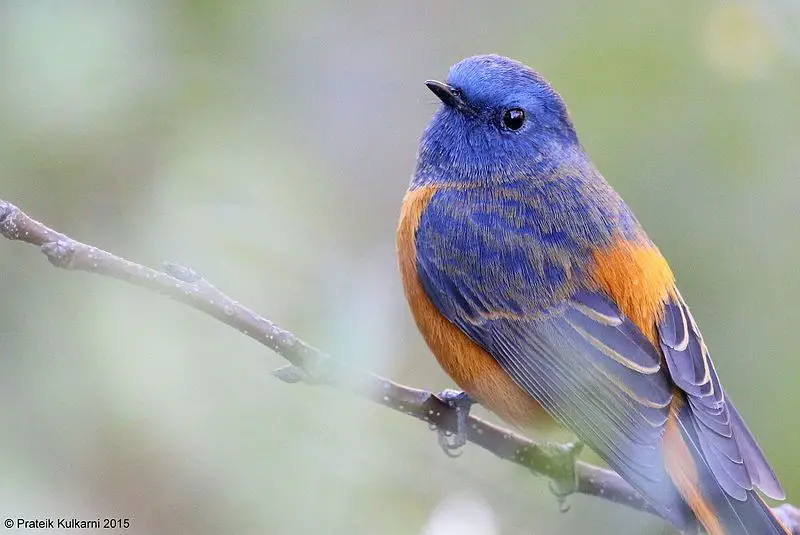
The blue-fronted redstart is a species of bird in the family Muscicapidae, which consists of Old World flycatchers. This species is endemic to certain parts of central China and the Himalayas.
It prefers to live in temperate forests, which are characterized by mild temperatures and moderate rainfall. The female blue-fronted redstart is brownish-grey in color, with paler underparts. This species is usually seen foraging for insects on the ground or in low vegetation.
They are known to migrate in winter to lower elevations and warmer climates. The blue-fronted redstart is a fairly common species and is considered to be of least concern on the IUCN Red List. It is also protected under the Convention on Migratory Species.
The conservation of this species is important for maintaining the balance of the environment.
| Kingdom | Animalia |
| Phylum | Chordata |
| Class | Aves |
| Order | Passeriformes |
| Family | Muscicapidae |
| Genus | Phoenicurus |
| Species | P. frontalis |
10. Himalayan Snowcock
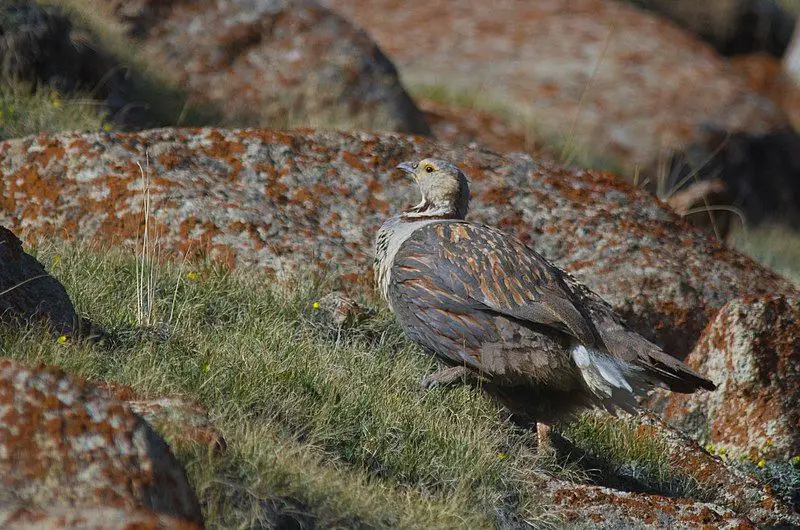
The Himalayan snowcock is a beautiful bird found in the pheasant family Phasianidae across the Himalayan ranges and parts of the adjoining Pamir range in Asia. It is a unique species of snowcock that has adapted to living in the alpine environment.
The snowcock can be found on alpine pastures as well as on steep rocky cliffs. This bird is a strong flier and has the ability to dive down the hill slopes to escape from predators.
The Himalayan snowcock has an impressive range of habitats from the high mountain peaks of the Himalayas to the lower elevations of the Pamir range. They are able to survive in such extreme altitudes due to their thick plumage which helps keep them warm in the cold temperatures.
The bird’s feathers can range from gray to brown, and its legs and feet are a bright yellow color. The Himalayan snowcock is omnivorous, feeding on seeds, grasses, and invertebrates. It is an adaptable species that can live in a variety of different environments.
It is also known to be quite territorial and will often defend its area from its competitors. The Himalayan snowcock is an impressive bird that has adapted to living in the extreme conditions of the Himalayas.
It is a strong flier and can dive down the hill slopes to escape from predators. This bird is an important part of the high-altitude ecosystems of the Himalayas and the adjoining Pamir range.
| Kingdom | Animalia |
| Phylum | Chordata |
| Class | Aves |
| Order | Galliformes |
| Family | Phasianidae |
| Genus | Tetraogallus |
| Species | T. himalayensis |
11. Kashmir Nuthatch
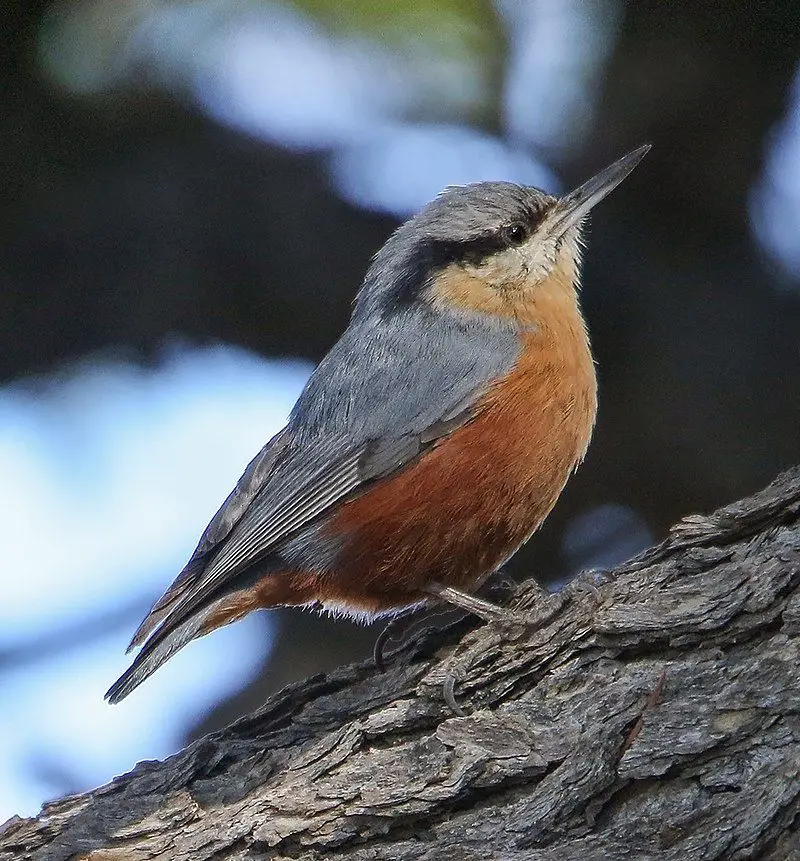
The Kashmir nuthatch is a species of bird belonging to the family Sittidae, which is a group of small passerine birds that includes treecreepers, wallcreepers, and nuthatches.
It is found in the northernmost regions of the Indian subcontinent, primarily in the mid-altitudes of the Himalayas, stretching across Afghanistan, India, Nepal, and Pakistan.
This species of bird has adapted to living in high altitudes and is well suited to the cold temperatures and rugged terrain of the Himalayas. Its diet consists mainly of insects, fruits, and nuts, which it forages for on the ground and in trees.
It is a medium-sized bird, typically around 15 cm in length, with a short bill, rounded wings, and a long tail. Its plumage is generally greyish-brown, with white streaks on the underside of its wings.
It is an active bird, often seen in pairs or small flocks, and makes a loud, sharp call which is often heard in the mountains. The Kashmir nuthatch is an important part of the Himalayan ecosystem, and its presence is a sign of a healthy, thriving environment.
| Kingdom | Animalia |
| Phylum | Chordata |
| Class | Aves |
| Order | Passeriformes |
| Family | Sittidae |
| Genus | Sitta |
| Species | S. cashmirensis |
12. White-tailed Nuthatch
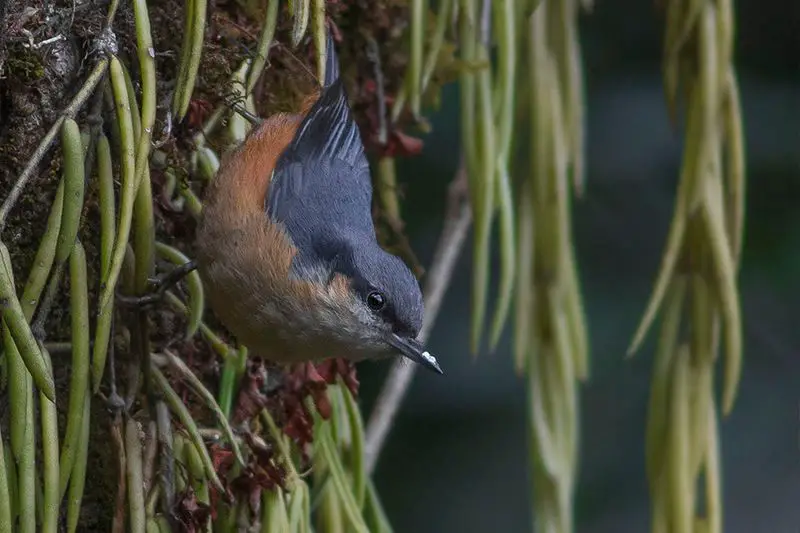
The white-tailed nuthatch is a species of bird that belongs to the family Sittidae. It is found throughout the northern and northeastern parts of the Indian Subcontinent, mainly inhabiting the low-to-middle Himalayas and associated mountain ranges.
This species of bird is native to many countries, such as Bhutan, India, Laos, Myanmar, Nepal, Tibet, and Thailand. The white-tailed nuthatch is typically found in forests and woodlands with dense undergrowth, as well as open scrublands and grasslands.
Its habitat includes evergreen and deciduous forests, as well as mangroves and riparian woodlands. It is often seen foraging for food on the ground, in low bushes, and in the trees.
Its diet consists mainly of insects such as beetles, moths, and caterpillars, as well as fruits, nuts, and seeds. The white-tailed nuthatch is a small bird measuring between 12 and 16 centimeters in length, with a wingspan of 22 to 25 centimeters.
Its plumage is mostly grey-brown with a white throat, a white crown, and a white tail. It also has a black bill, black legs, and reddish eyes. The white-tailed nuthatch is generally a solitary bird, although it can sometimes be seen in pairs or in small family groups.
During the breeding season, it is known to form small flocks. It is an active and vocal bird, and its calls are often heard in its habitat. The white-tailed nuthatch is an important species in its native habitats, playing an important role in the local ecosystem.
It helps to control local populations of insects, as well as disperse fruit and nut seeds, which help to maintain healthy forests and woodlands.
| Kingdom | Animalia |
| Phylum | Chordata |
| Class | Aves |
| Order | Passeriformes |
| Family | Sittidae |
| Genus | Sitta |
| Species | S. himalayensis |
13. Koklass Pheasant
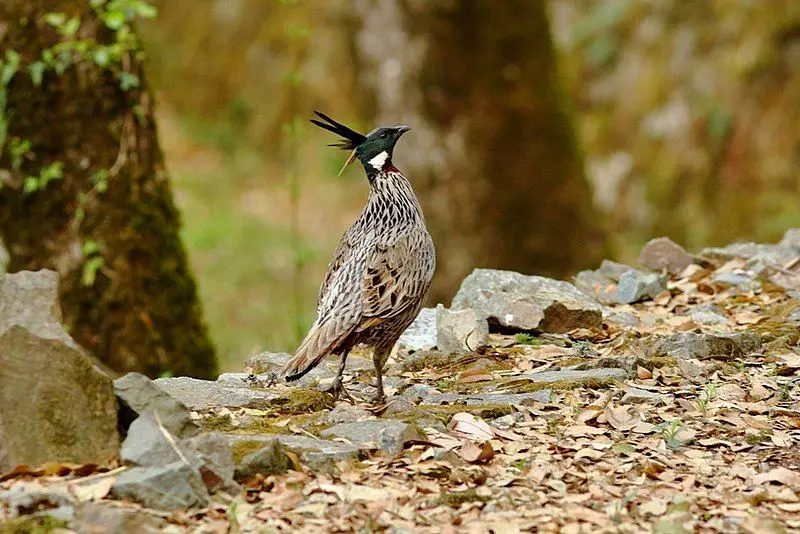
The koklass pheasant is a species of gamebird that is part of the pheasant family. It is closely related to grouse that lived in the Miocene Epoch, which occurred between 5.3 and 23 million years ago.
Koklass pheasants are more distant relatives of pheasants and are most closely related to grouse and turkeys. They are the only species in the monotypic genus Pucrasia.
This means that koklass pheasants are one of a kind and have no other species in their genus. Koklass pheasants are found in the Himalayan mountains of India, Nepal, and Bhutan.
They inhabit temperate, subtropical, and alpine forests, where they feed on a variety of plant matter such as fruits, buds, shoots, and leaves. They are known for their elaborate courtship displays, which involve a series of loud cries and wing-flapping.
They also have distinctive plumage, which is brown and white with a black crest on the head. Koklass pheasants have been hunted for centuries for their meat and feathers.
In recent years, however, their numbers have been declining due to habitat loss, hunting, and predation by wild cats.
Conservation efforts have been put in place to protect this species, and it is listed as “near threatened” by the International Union for Conservation of Nature.
| Kingdom | Animalia |
| Phylum | Chordata |
| Class | Aves |
| Order | Galliformes |
| Family | Phasianidae |
| Genus | Pucrasia |
| Species | P. macrolopha |
14. Himalayan Bluetail
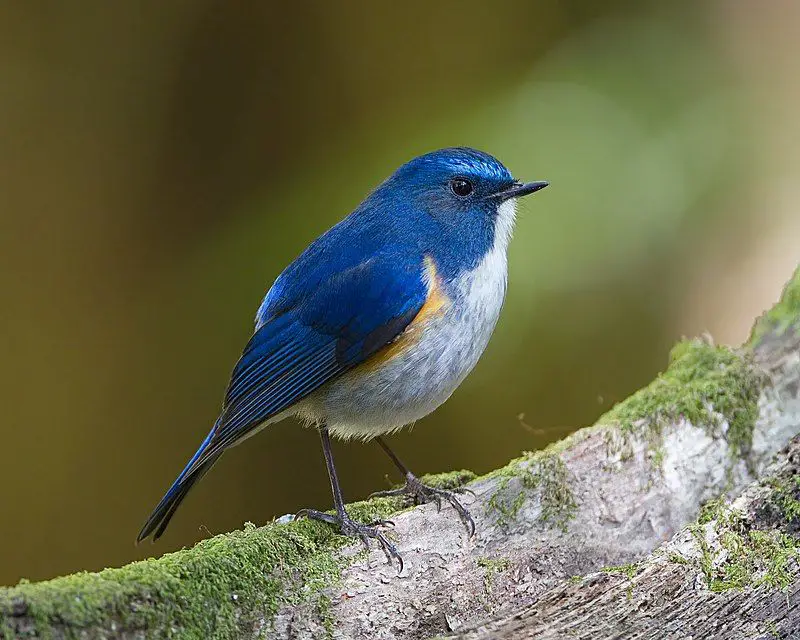
The Himalayan bluetail is a small bird belonging to the passerine family. It is also known as the Himalayan red-flanked bush-robin or orange-flanked bush-robin. Traditionally, it was classified as a member of the thrush family Turdidae.
However, in recent times, it is commonly considered to be a member of the Old World flycatcher family Muscicapidae. The Himalayan bluetail is a small bird with a wide range of habitats.
It is found in the Himalayan mountain range and also in parts of Pakistan, India, Nepal, and Bhutan. It is a common bird and is often seen in gardens and parks. It has a reddish-brown back and wings with white underparts.
The tail is light blue. The Himalayan bluetail is an omnivore, feeding on insects, berries, and small amphibians. It forages on the ground and takes short flights to catch insects in midair. It is usually seen in pairs or small flocks.
It is also known to join mixed flocks of other species. The nesting season for the Himalayan bluetail is usually late April to mid-July. It builds its nest in a thick bush or tree. The nest is a cup-shaped structure made of twigs and grass. The female lays two to four eggs.
Both parents take part in the incubation and feeding of the young. The Himalayan bluetail is an important species in the Himalayan ecosystem.
With its unique combination of bright colors and its wide range of habitats, this species is an important part of the ecosystem’s biodiversity.
| Kingdom | Animalia |
| Phylum | Chordata |
| Class | Aves |
| Order | Passeriformes |
| Family | Muscicapidae |
| Genus | Tarsiger |
| Species | T. rufilatus |
15. Snow Pigeon
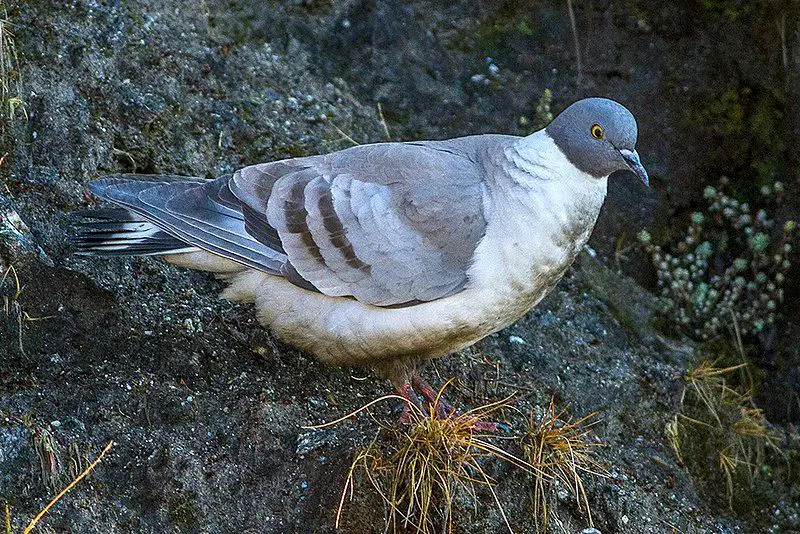
The snow pigeon is a species of bird belonging to the Columba genus in the Columbidae family. It is native to hilly regions of central Asia. This species of pigeon is usually white colored, with a greyish shade on its wings and tail. Its legs and feet are pinkish in color.
The snow pigeon is a medium-sized bird, measuring around 30 cm in length, and has a wingspan of around 50 cm. Its head is slightly larger than its body and its wings are rounded and short. It has a short beak with a black tip.
The snow pigeon primarily feeds on grains, seeds, fruits, and vegetation. It is also known to eat insects and other small animals. They usually forage in flocks, searching for food on the ground.
In the winter months, they congregate in large numbers to roost in cliffs and trees. During the breeding season, they form pairs and nest in cavities or on ledges in cliff faces. The female snow pigeon lays two white eggs that hatch after two weeks.
Both parents help raise the young until they reach maturity. The snow pigeon is an important species in its native habitat, as it plays an important role in the environment by dispersing seeds and dispersing nutrients between habitats.
It is not considered to be threatened or endangered, but it is still important to conserve its natural habitats in order to protect this species.
| Kingdom | Animalia |
| Phylum | Chordata |
| Class | Aves |
| Order | Columbiformes |
| Family | Columbidae |
| Genus | Columba |
| Species | C. leuconota |
16. White-naped Yuhina
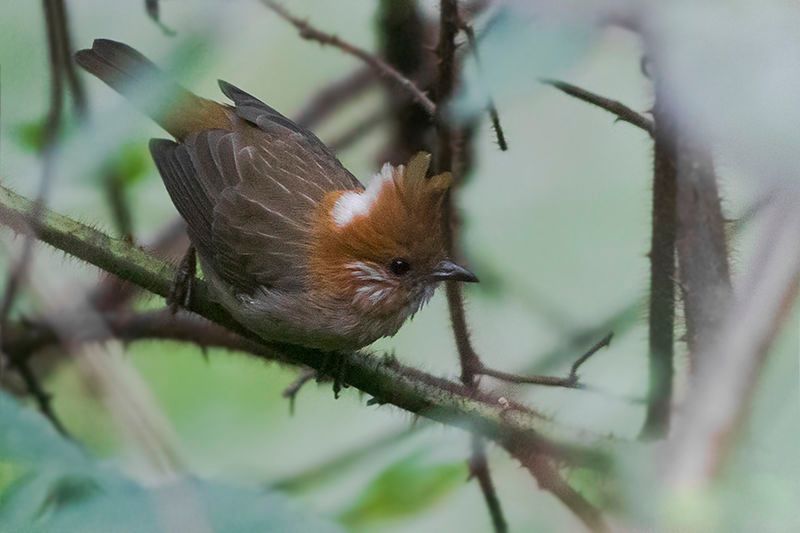
The white-naped yuhina is an exotic species of bird that belongs to the white-eye family Zosteropidae. It is native to the Himalayas, extending to northern Myanmar.
This species of bird can be found living in a variety of habitats, ranging from temperate forests to subtropical or tropical moist lowland forests. The white-naped yuhina is a small, sparrow-like bird that has a distinct white stripe on its head.
It has a greyish-green back and wings, and a yellow underside. It has brown eyes, and a strong, curved bill. The white-naped yuhina feeds on various insects and fruit, foraging on the ground or in trees and bushes. It is a social bird, and can often be seen in small flocks.
It is a vocal species, with a melodious song composed of trills, whistles, and chirps. The white-naped yuhina is an important species in both the Himalayas and Myanmar and is listed as Near Threatened by the IUCN Red List.
As such, conservation efforts are being made to ensure the species does not become threatened in the future.
| Kingdom | Animalia |
| Phylum | Chordata |
| Class | Aves |
| Order | Passeriformes |
| Family | Zosteropidae |
| Genus | Yuhina |
| Species | Y. bakeri |
17. Slaty-headed Parakeet
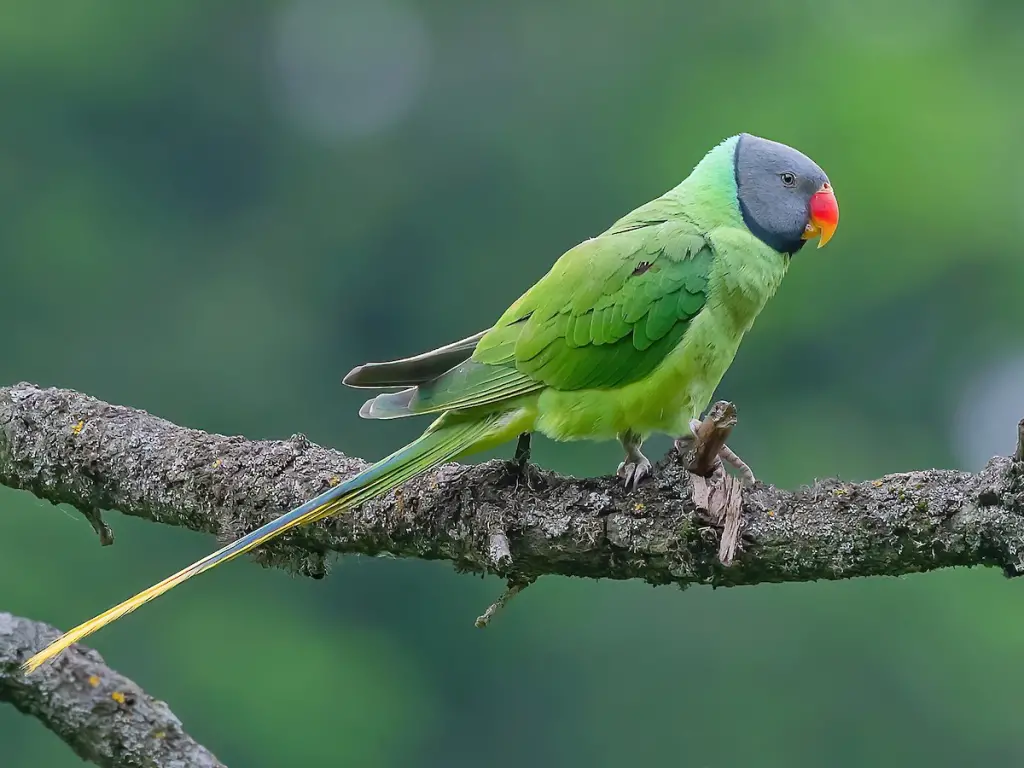
Source: ebird.org
The slaty-headed parakeet is a species of psittacid, or parrot, that is known for its altitudinal migration. This means that the species migrates between different altitudes, usually based on the climate and availability of food.
The range of the slaty-headed parakeet extends from Pakistan to the western Himalayas in India, through Nepal and Bhutan, and up to the eastern Himalayas in the northeastern Indian state of Arunachal Pradesh.
This range covers a wide variety of climates, ranging from low-lying, hot, and dry areas to high-altitude, cold, and wet areas.
As a result, the species is able to exploit the different conditions in each of these regions and migrate between them in order to find the optimal environment for food and survival.
This ability to migrate between different altitudes is the reason why the slaty-headed parakeet is the only species of psittacid to exhibit altitudinal migration, making it unique amongst its peers.
| Kingdom | Animalia |
| Phylum | Chordata |
| Class | Aves |
| Order | Psittaciformes |
| Family | Psittacidae |
| Genus | Himalayapsitta |
| Species | H. himalayana |
18. Tibetan Blackbird
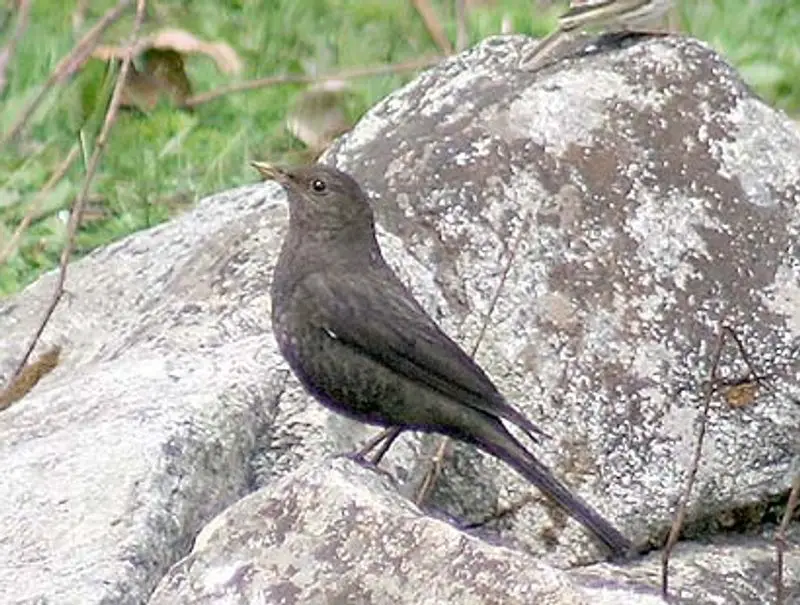
The Tibetan blackbird is a species of bird belonging to the thrush family, Turdidae. This species of bird is found in the Himalaya mountains, spanning from northern Pakistan to southeastern Tibet.
The Himalayas are a mountain range in Asia, stretching from the Hindu Kush in the west to the Arakan Yoma in the east.
The Tibetan blackbird is a small bird, usually measuring between 7-10 inches in length, and has a distinctive black plumage which is often highlighted with a reddish-brown hue.
It is a generally solitary bird, preferring to keep to its own territory, and is known to feed on fruits, insects, and small vertebrates.
The Tibetan blackbird is listed as a species of Least Concern by the International Union for Conservation of Nature, as its population appears to be stable and not threatened by human activity.
| Kingdom | Animalia |
| Phylum | Chordata |
| Class | Aves |
| Order | Passeriformes |
| Family | Turdidae |
| Genus | Turdus |
| Species | T. maximus |
19. White-throated Bushtit
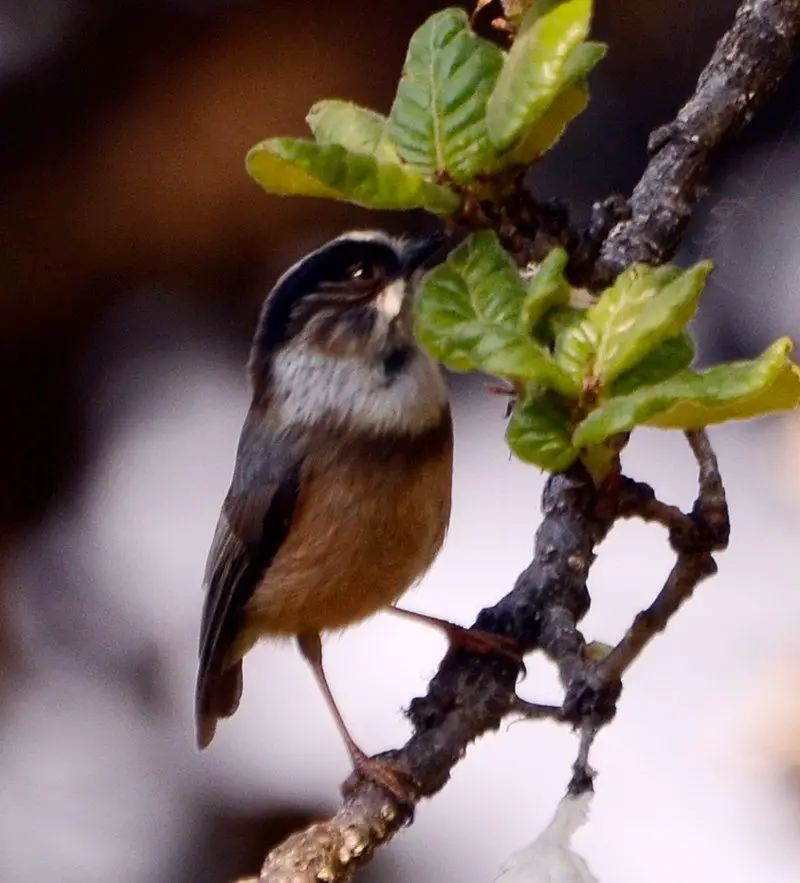
The white-throated bushtit, also known as the white-throated tit, is a species of bird in the family Aegithalidae. It is a small, nondescript bird, having a slender body, a short tail, and a small head. It has a white throat and greyish-brown upperparts and wings.
It can be spotted in India, Nepal, and Pakistan. The white-throated bushtit’s preferred habitat is subtropical or tropical moist montane forests. It is typically seen in the understory of these forests, where it feeds on small insects and spiders.
It is usually found in pairs or small flocks and is known for its ant-like feeding behavior. It is a vocal bird, and its call is a sharp, metallic “tit-tit-tit” sound. Overall, the white-throated bushtit is an interesting species of bird found in India, Nepal, and Pakistan.
It is adapted to living in the low-lying understory of tropical forests, where it feeds on small insects and spiders. Its distinctive call adds to the charm of the bird, making it a pleasure to watch.
| Kingdom | Animalia |
| Phylum | Chordata |
| Class | Aves |
| Order | Passeriformes |
| Family | Aegithalidae |
| Genus | Aegithalos |
| Species | A. niveogularis |
20. Ward’s Trogon
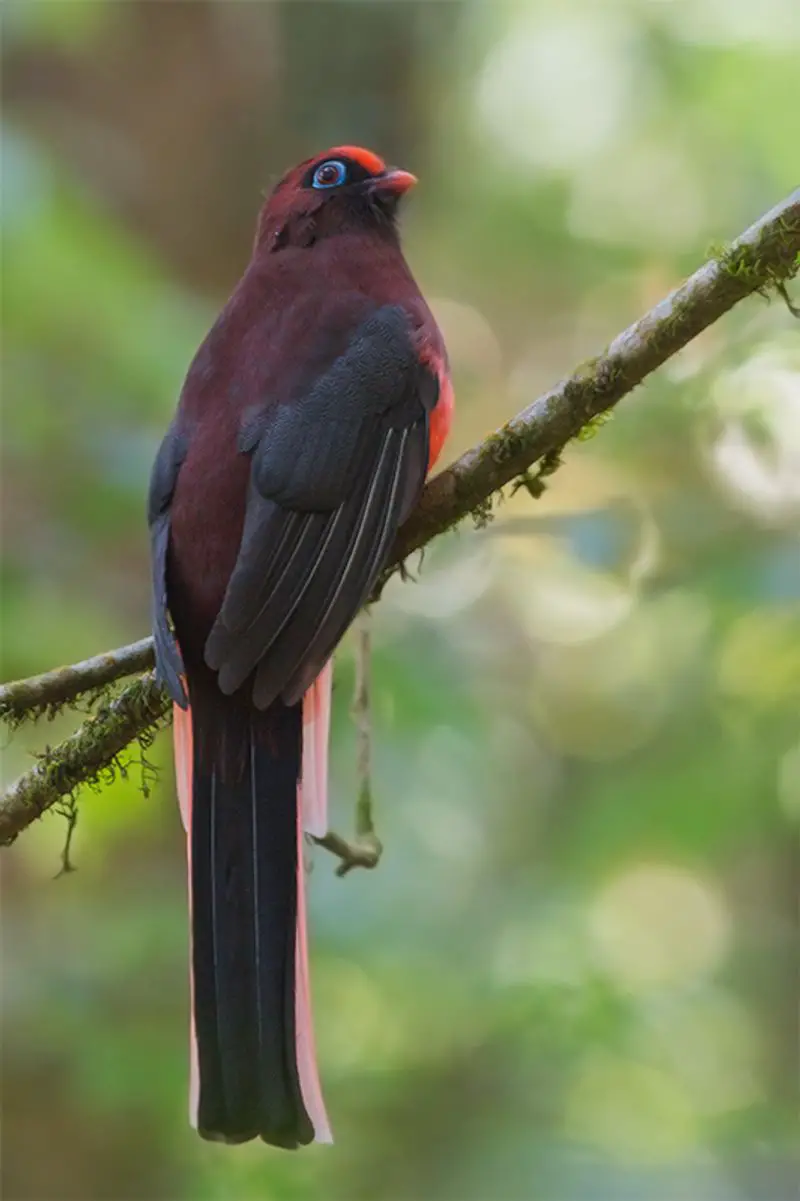
Ward’s trogon is a species of bird that is found in the family Trogonidae. Its range is located in the northeastern parts of the Indian subcontinent and stretches eastwards into Southeast Asia. This species is found in Bhutan, India, Tibet, and Myanmar.
Interestingly, there is also an isolated population of this species located in northern Vietnam. However, there haven’t been any recent records of this species from this region.
| Kingdom | Animalia |
| Phylum | Chordata |
| Class | Aves |
| Order | Trogoniformes |
| Family | Trogonidae |
| Genus | Harpactes |
| Species | H. wardi |
21. Blyth’s Tragopan
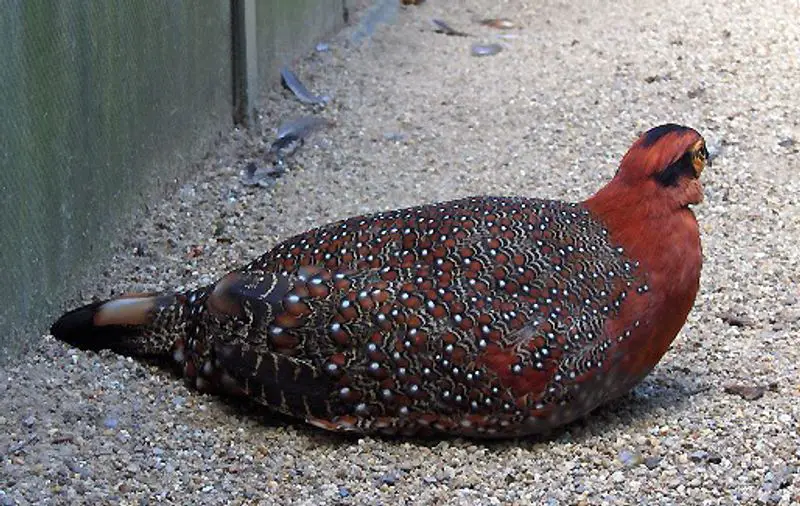
Edward Blyth was an English zoologist and curator of the Museum of the Asiatic Society of Bengal. His name is used to commemorate a pheasant species known as Blyth’s tragopan or the grey-bellied tragopan.
This species is currently classified as vulnerable, which means that it is facing a high risk of extinction in the near future. The grey-bellied tragopan is native to the foothills of the Himalayas, stretching across India, Nepal, Bhutan, and parts of Tibet.
It is a medium-sized bird with a length of around 55 cm and a wingspan of around 76 cm. The male has a distinctive blue face, chest, and neck, while the female is paler in coloration.
These birds mainly feed on fruit and insects, and they inhabit evergreen and deciduous forests. Unfortunately, the grey-bellied tragopan is facing a number of threats, such as habitat loss, poaching, and competition with other species.
These threats have caused a decline in the population of this species, and it is now listed as vulnerable on the IUCN Red List. Conservation efforts such as habitat protection and anti-poaching campaigns are needed to help protect this species and ensure its survival.
| Kingdom | Animalia |
| Phylum | Chordata |
| Class | Aves |
| Order | Galliformes |
| Family | Phasianidae |
| Genus | Tragopan |
| Species | T. blythii |
22. Western Tragopan
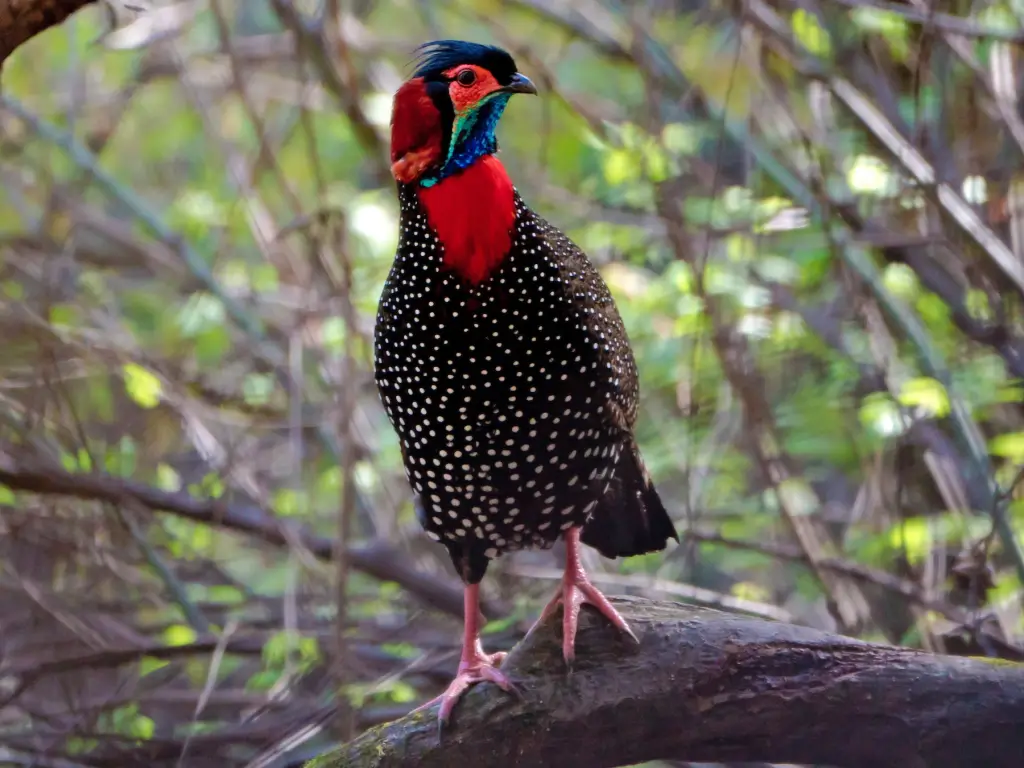
The western tragopan (also known as the western horned tragopan) is a species of pheasant native to the Himalayan mountain range. It is a medium-sized bird, with bright plumage and a distinctive horn-like protrusion on its head.
It is found in a narrow strip of land stretching from the northeastern districts of Khyber Pakhtunkhwa province in northern Pakistan in the west to Uttarakhand within India to the east.
Unfortunately, the western tragopan is considered to be a highly endangered species and is listed as globally threatened. The species is threatened by a number of factors, including human encroachment on its habitat, hunting, and the destruction of its natural environment.
As a result, its population has been steadily declining over the past few decades. Conservation efforts are underway to help protect the species, including strictly protected areas, captive breeding programs, and public education campaigns.
However, much more needs to be done to ensure the survival of the western tragopan in the wild.
| Kingdom | Animalia |
| Phylum | Chordata |
| Class | Aves |
| Order | Galliformes |
| Family | Phasianidae |
| Genus | Tragopan |
| Species | T. melanocephalus |
23. Sclater’s Monal
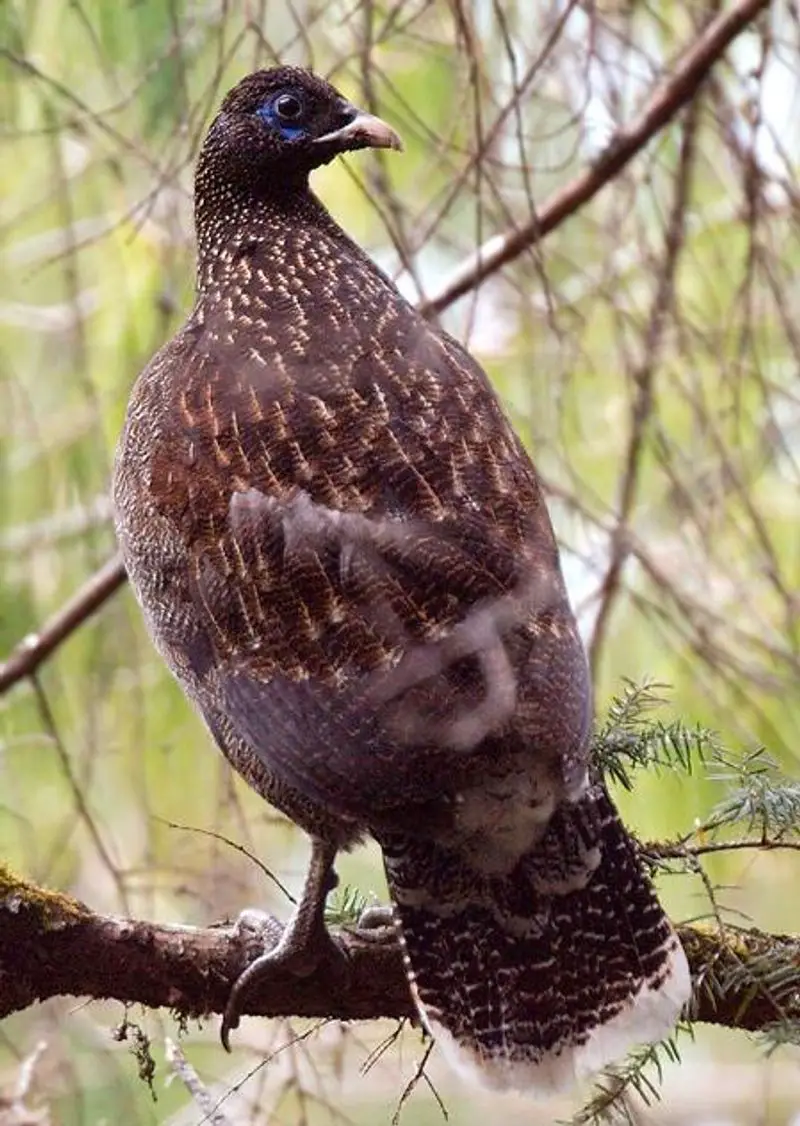
The Sclater’s monal, also referred to as the crestless monal, is a species of Himalayan pheasant. This species was discovered and named in honor of the British zoologist Philip Lutley Sclater.
Sclater was known for his wide-ranging research in ornithology, and his naming of the Sclater’s monal is considered one of his most significant contributions to the field. The Sclater’s monal has several unique features that set it apart from other species of pheasant.
It is distinguished by its lack of a crest, which gives it its common name. The bird is a medium-sized species, with a bright green head and neck, and a metallic blue-green back, wings, and tail.
The male also has a bright red throat patch, and both sexes have black stripes running down their sides. The Sclater’s monal is found in the Himalayan region of India, Nepal, Bhutan, and parts of Tibet and Myanmar.
It prefers to inhabit areas of dense forests at elevations of between 2000 and 4000 meters.
In these areas, it is often seen foraging on the ground or perched in trees. The Sclater’s monal is considered to be an important species in the region, as it is an indicator of the health of the forest ecosystems.
The species is also listed as Near Threatened on the IUCN Red List, due to habitat loss and degradation. To ensure the continued survival of the species, conservation efforts must be undertaken to protect its habitat.
| Kingdom | Animalia |
| Phylum | Chordata |
| Class | Aves |
| Order | Galliformes |
| Family | Phasianidae |
| Genus | Lophophorus |
| Species | L. sclateri |
24. Rusty-bellied Shortwing
The rusty-bellied shortwing is a species of bird that belongs to the Muscicapidae family. This species of bird can be found in three different regions: Yunnan, Northeast India, and far northern Myanmar.
It is mainly seen in subtropical or tropical moist environments, which include lowland forests, montane forests, and shrublands. This type of bird is adapted to living in areas of high humidity and moisture, as they are able to thrive in such an environment.
The rusty-bellied shortwing is an important part of the ecosystems of the areas in which it is found, and it plays an important role in the balance of the natural world.
| Kingdom | Animalia |
| Phylum | Chordata |
| Class | Aves |
| Order | Passeriformes |
| Family | Muscicapidae |
| Genus | Brachypteryx |
| Species | B. hyperythra |
25. Kashmir Flycatcher
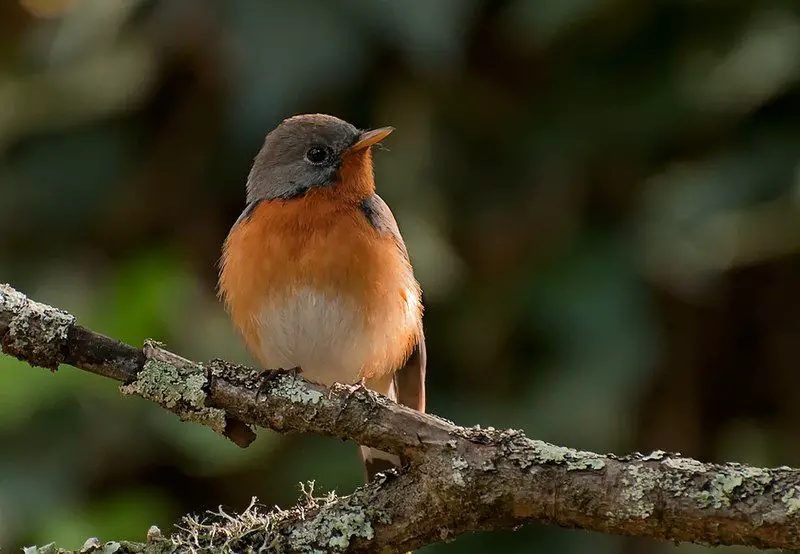
The Kashmir flycatcher is a species of bird that belongs to the Muscicapidae family, which is part of the passerine group of birds. This species is native to the Northwest Himalayas, where it breeds, but it spends the winter in southern India and Sri Lanka.
It is closely related to the red-breasted flycatcher, Ficedula parva, and it was previously thought to be a subspecies of the same species. As a flycatcher, this species is characterized by its ability to catch flying insects, which it uses to feed itself.
It is a small bird, with a wingspan of around 16-17 cm. Its plumage is typically greyish-brown, with white spots and a reddish head, which gives it its common name.
The Kashmir flycatcher is an important part of the avian diversity of the region, and it is an important part of the local ecosystem.
| Kingdom | Animalia |
| Phylum | Chordata |
| Class | Aves |
| Order | Passeriformes |
| Family | Muscicapidae |
| Genus | Ficedula |
| Species | F. subrubra |
26. Orange Bullfinch
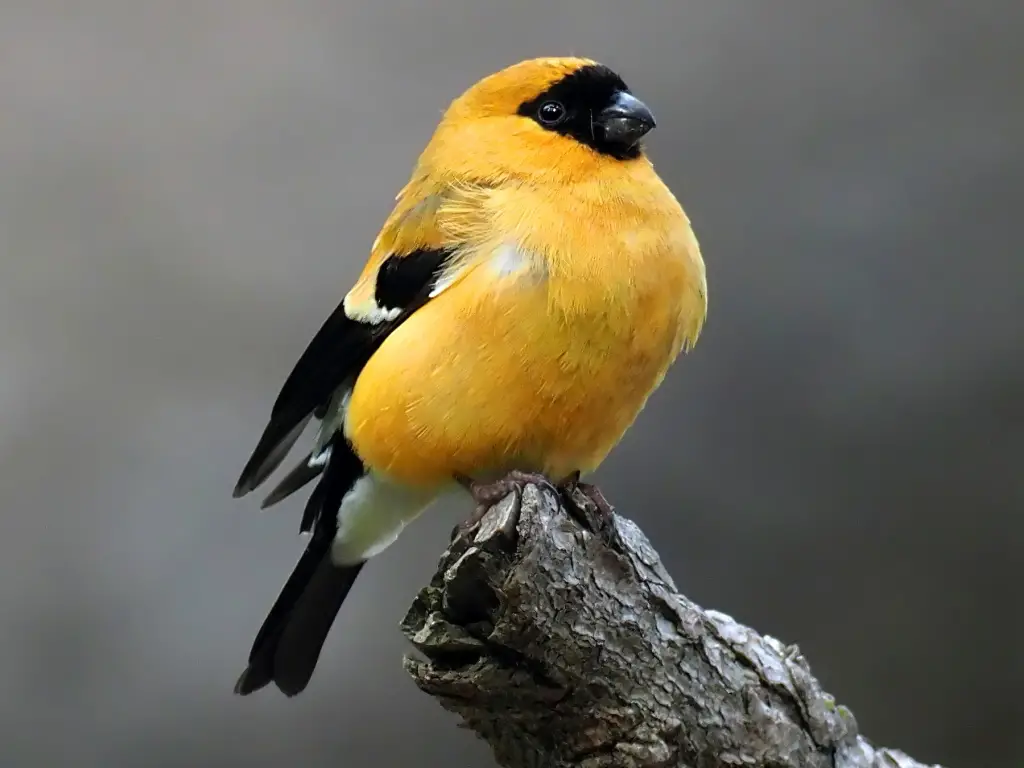
Source: ebird.org
The orange bullfinch is a type of small bird belonging to the Fringillidae family. It can be found in India and Pakistan, usually in temperate forests. This species of finch is known for its striking orange plumage, which stands out in its natural environment.
Its beak is short and stubby, and its tail is long and pointed. It has a strong, curved bill and powerful flight muscles. The orange bullfinch is a gregarious species, often seen in small flocks. Its diet consists mainly of seeds, fruits, and insects.
It is an important part of the food chain in its natural habitat, providing food for larger birds and mammals.
It is also an important pollinator, helping to spread pollen from one plant to another. The orange bullfinch is a species of conservation concern, as its populations are declining due to habitat destruction and fragmentation. It is listed as near-threatened on the IUCN Red List.
Conservation efforts are needed to protect this species and its habitat, as well as to help ensure its long-term survival.
| Kingdom | Animalia |
| Phylum | Chordata |
| Class | Aves |
| Order | Passeriformes |
| Family | Fringillidae |
| Genus | Pyrrhula |
| Species | P. aurantiaca |
27. Black-headed Jay

Source: ebird.org
The black-headed jay, also known as the lanceolated jay, is a bird that is similar in size to its close relative the Eurasian jay. Although it is generally a little more slender than the Eurasian jay, the bill of the black-headed jay is slightly shorter and thicker.
The plumage of the bird is particularly distinctive, with the top of the head being black and the bird having a more obvious crest than its relative. The black-headed jay also has a longer tail than the Eurasian jay.
This bird is found across Europe and Asia and is a common sight in deciduous woodlands. It is a sociable bird, often found in small flocks and engaging in playful activities such as chasing one another through the trees.
The black-headed jay is an omnivore, feeding on a wide variety of plant matter, insects, small reptiles, and even the eggs and nestlings of other birds. This species is not currently considered to be under any major threat and its population is stable.
| Kingdom | Animalia |
| Phylum | Chordata |
| Class | Aves |
| Order | Passeriformes |
| Family | Corvidae |
| Genus | Garrulus |
| Species | G. lanceolatus |
28. Hoary-throated Barwing

Source: ebird.org
The hoary-throated barwing is a species of bird belonging to the family Leiothrichidae. It is found in the northern parts of the Indian subcontinent, primarily in the Eastern Himalayas.
This species ranges across four countries in the region: Bhutan, India, Tibet, and Nepal. The hoary-throated barwing is a small bird with a distinctive gray-brown body and black and white spotted wings. It has a unique white throat patch that gives it its name.
This species is mostly found in mountainous areas and prefers to inhabit forests. It is known to feed mainly on insects and small fruits. The hoary-throated barwing is not a common species and is considered to be threatened in some parts of its range.
The species is facing a number of threats, including habitat destruction and fragmentation due to human activities. Other threats include poaching and egg collection for food. Conservation efforts are needed to protect this species and ensure its survival in the wild.
| Kingdom | Animalia |
| Phylum | Chordata |
| Class | Aves |
| Order | Passeriformes |
| Family | Leiothrichidae |
| Genus | Actinodura |
| Species | A. nipalensis |
29. Great Barbet
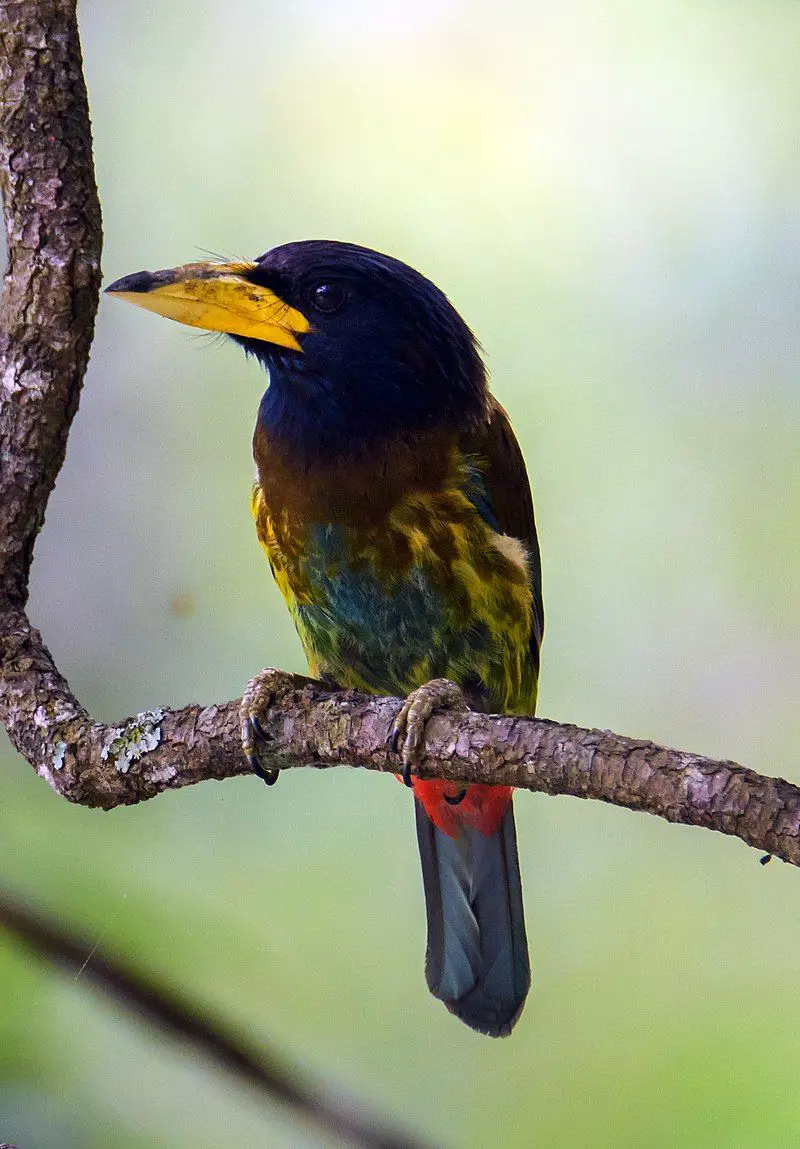
The Great Barbet is a species of bird that is found in the Indian subcontinent and Southeast Asia. It is a type of Asian barbet, a group of birds that are found in tropical and subtropical climates.
The Great Barbet inhabits forested areas and is usually found at altitudes of up to 3,000 meters.
Its distribution is wide, and as a result, the International Union for Conservation of Nature (IUCN) has classified it as Least Concern – meaning it is not at risk of extinction – since 2004.
The Great Barbet is a medium-sized bird, typically measuring around 25cm in length, and weighing up to 50g. It has distinctive black, white, and orange plumage, and its head is often adorned with a crest of feathers.
Its diet consists mainly of fruits, but it also eats insects, flower nectar, and some small birds and lizards. The Great Barbet is a solitary species and is usually found in pairs or small family groups.
They are often seen perched on high branches, and they are most active during the early morning and late afternoon. They make their nests in tree hollows, and the female will lay two to three eggs.
The chicks will fledge after about three weeks, and the parents will look after them for another two months before they become independent. The Great Barbet is an important species in the ecosystem due to its role in seed dispersal and insect control.
Despite this, its population is threatened by habitat loss and fragmentation due to human activity, and as a result, conservation efforts are needed to ensure its future survival.
| Kingdom | Animalia |
| Phylum | Chordata |
| Class | Aves |
| Order | Piciformes |
| Family | Megalaimidae |
| Genus | Psilopogon |
| Species | P. virens |
30. Black Bulbul
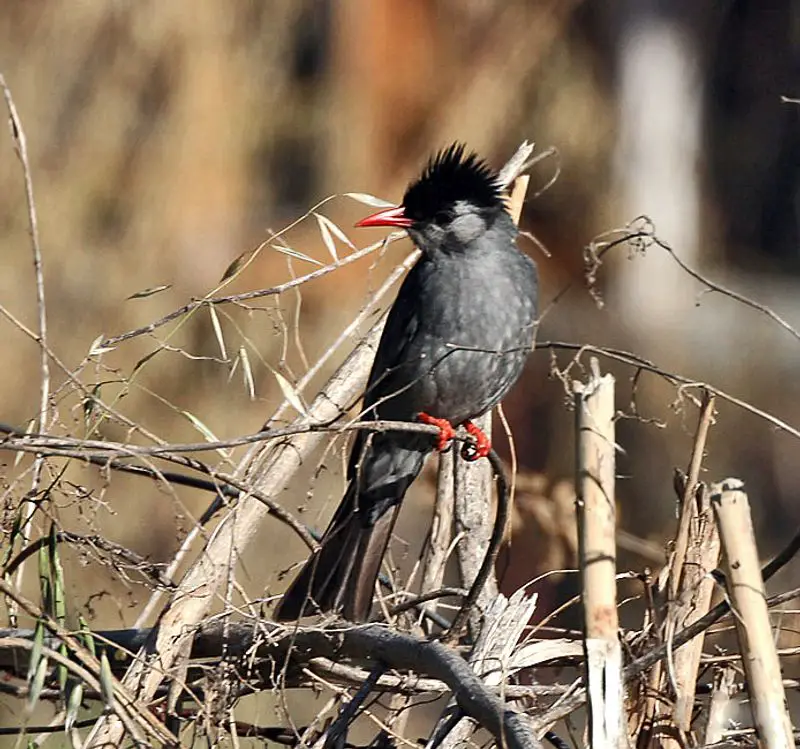
The black bulbul is a species of passerine bird belonging to the bulbul family. It is native to much of the Himalayas and its range extends eastward from India to parts of Southeast Asia. This bird is also known as the Himalayan black bulbul or Asian black bulbul.
The black bulbul is a medium-sized bird that is mostly black in color. Its wings, tail, and throat are marked with white patches and its beak is yellow. Its diet consists mainly of fruits, insects, and small reptiles.
The black bulbul is found in a variety of habitats, including scrubland, grasslands, and forests. It can often be seen in urban gardens and parks. The black bulbul is a social bird that usually forms large flocks and can be heard singing loudly in the early morning hours.
It is a sedentary bird, meaning that it rarely migrates and typically remains in its native range throughout the year.
| Kingdom | Animalia |
| Phylum | Chordata |
| Class | Aves |
| Order | Passeriformes |
| Family | Pycnonotidae |
| Genus | Hypsipetes |
| Species | H. leucocephalus |
31. Verditer Flycatcher
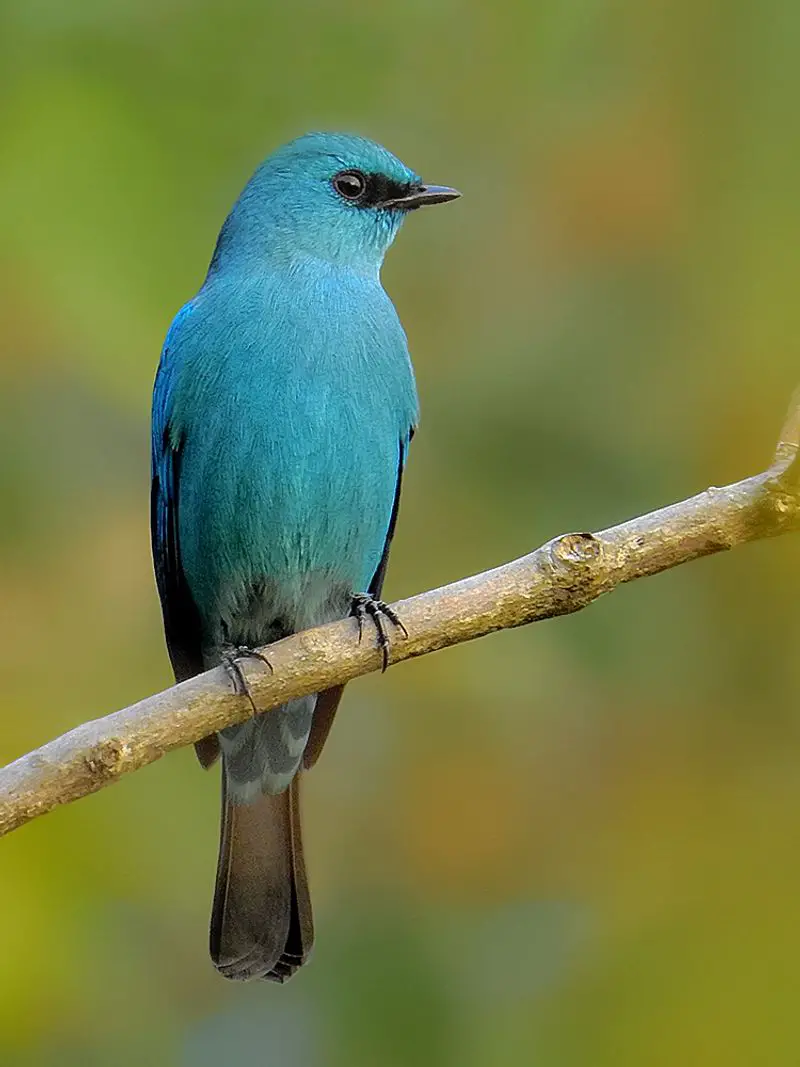
The verditer flycatcher is a beautiful and distinct species of Old World flycatcher. It is found in the Himalayas, through Southeast Asia, and all the way to Sumatra.
This species is named after its unique shade of copper-sulfate blue, which is often likened to a verdigris patina. Its other distinct feature is a dark patch between the eyes and above the base of its bill. This patch is more noticeable in the males of the species.
The verditer flycatcher is an active and agile bird, often seen flitting and fluttering among the trees and bushes. It feeds mainly on insects, which it catches on the wing. It also has an attractive song, consisting of a series of high-pitched whistles and chirps.
All in all, the verditer flycatcher is an attractive and interesting species, which is well worth looking out for.
| Kingdom | Animalia |
| Phylum | Chordata |
| Class | Aves |
| Order | Passeriformes |
| Family | Muscicapidae |
| Genus | Eumyias |
| Species | E. thalassinus |
32. Spiny Babbler
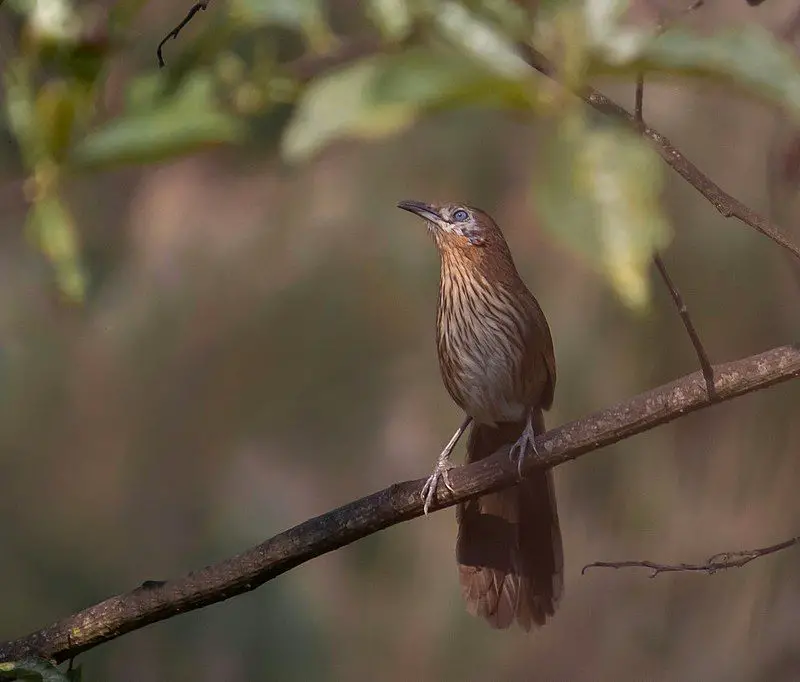
The spiny babbler is a species of bird that is found exclusively in the Middle Hills of Nepal.
This bird is part of the family Leiothrichidae, and it can be seen in the Kathmandu Valley, particularly around the Godavari and Phulchoki areas near the city of Lalitpur. This species of bird is known for its spiny feathers, which have a unique texture.
It is also known for its distinctive call, which is described as a loud, harsh chatter. The spiny babbler is a social species, usually seen in small flocks.
They usually live in humid forest areas, but can also be found in grasslands and scrublands. The spiny babbler feeds on a wide variety of nutrients, including insects, fruits, and berries. It also has a fondness for seeds and grain, so it is often seen near human settlements.
This species of bird is an important part of the local ecosystem, as it helps with pollination and seed dispersal. Despite its limited range, the spiny babbler is not considered to be endangered.
However, its population is declining due to habitat loss and fragmentation, as well as the introduction of invasive species. Therefore, conservation efforts are necessary to ensure the long-term survival of this species.
| Kingdom | Animalia |
| Phylum | Chordata |
| Class | Aves |
| Order | Passeriformes |
| Family | Leiothrichidae |
| Genus | Turdoides |
| Species | T. nipalensis |
33. Streak-throated Barwing
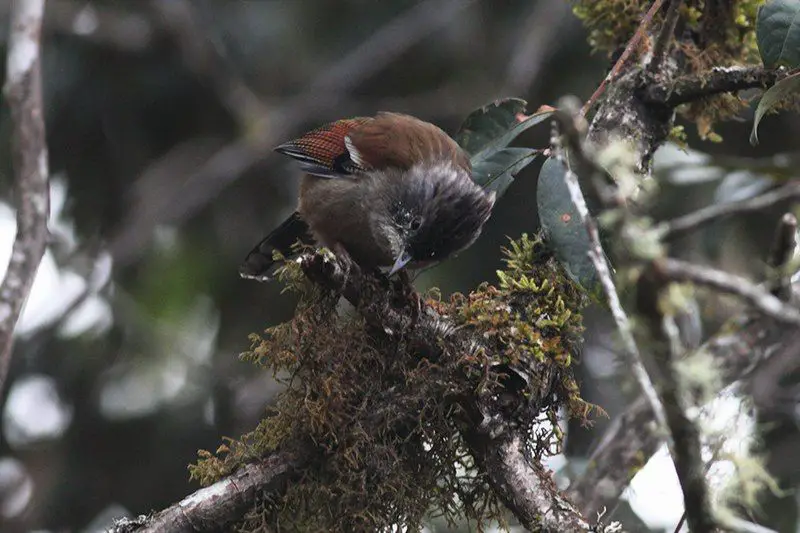
The streak-throated barwing is a species of bird belonging to the family Leiothrichidae. It is a species of bird endemic to the mountainous regions of western Yunnan, southern Tibet, Northeast India, and Myanmar.
Its natural habitat consists of subtropical or tropical moist montane forests, which are characterized by plentiful amounts of precipitation and a temperate climate.
The barwing is usually found in areas of thick foliage or dense undergrowth, where it can feed on the abundance of insects and berries that are available. They are also known to inhabit humid grasslands and bamboo forests, as well as coniferous forests in higher elevations.
The streak-throated barwing is an important indicator species, as its presence can be used to measure the health of the environment in which it resides.
Its presence is usually indicative of a healthy ecosystem and its absence suggests an environment that is suffering from human pressures. For this reason, conservation efforts are necessary to ensure the long-term survival of this species and the habitats it calls home.
| Kingdom | Animalia |
| Phylum | Chordata |
| Class | Aves |
| Order | Passeriformes |
| Family | Leiothrichidae |
| Genus | Actinodura |
| Species | A. waldeni |
34. Himalayan Rubythroat
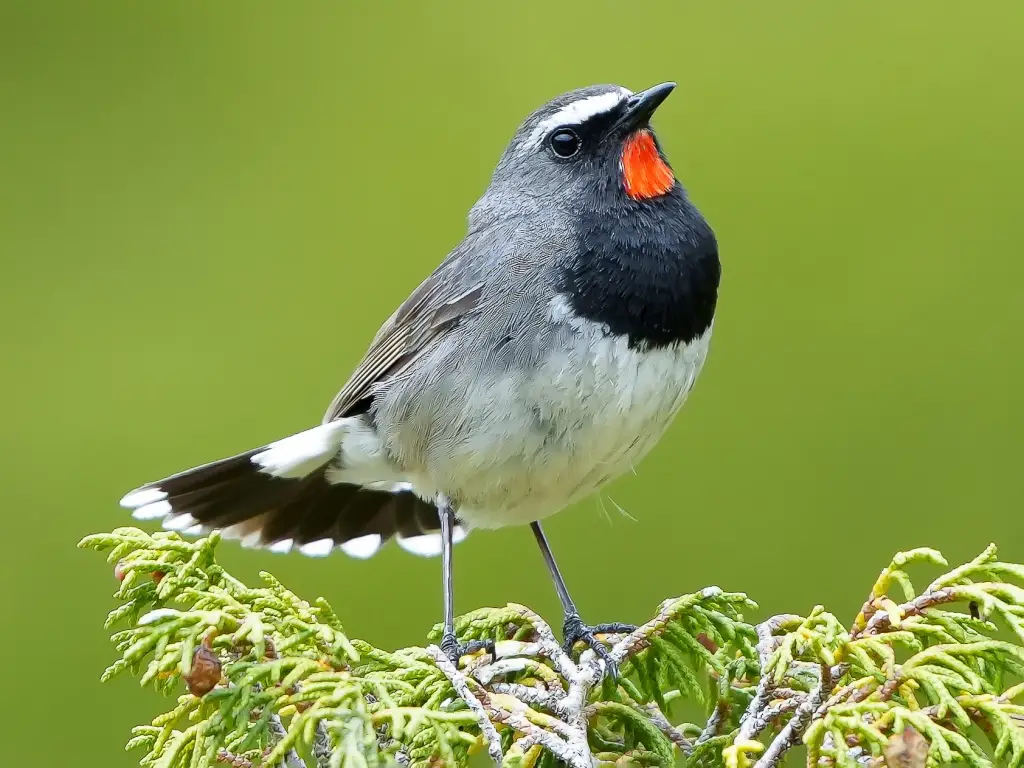
Source: ebird.org
The Himalayan Rubythroat is a songbird belonging to the family of Muscicapidae. It is closely related to the Siberian Rubythroat and is easily distinguished by the presence of a distinctive white tail tip and white tail base.
This species of bird is found in the mountainous regions of central Asia, inhabiting the Himalayas, Hindu Kush, Pamirs, and Karakoram ranges.
It has a strong preference for mountain slopes, ravines, and valleys, typically living in elevations ranging from 1,500 to 4,500 meters. The Himalayan Rubythroat has a medium-sized body, measuring about 16 centimeters in length.
It has a grayish-brown head with white cheeks, a black throat, and a red breast. It also has a white tail tip and white tail base, which is the main distinguishing feature between it and the Siberian Rubythroat.
The wings are brownish-black with white edges, and the legs are pinkish-gray. The bird mainly feeds on insects, berries, and nectar. It is active during the day, usually seen in flocks of up to 30 individuals.
The Himalayan Rubythroat is a migratory species, migrating from Central Asia to South Asia and Southeast Asia in winter. The Himalayan Rubythroat is listed as a Near Threatened species by the IUCN due to habitat loss and fragmentation, as well as capture for the pet trade.
Conservation efforts are underway to protect this species and its habitat, such as the establishment of protected areas and the promotion of sustainable agriculture and forestry practices..
| Kingdom | Animalia |
| Phylum | Chordata |
| Class | Aves |
| Order | Passeriformes |
| Family | Muscicapidae |
| Genus | Calliope |
| Species | C. pectoralis |
35. Bulbul
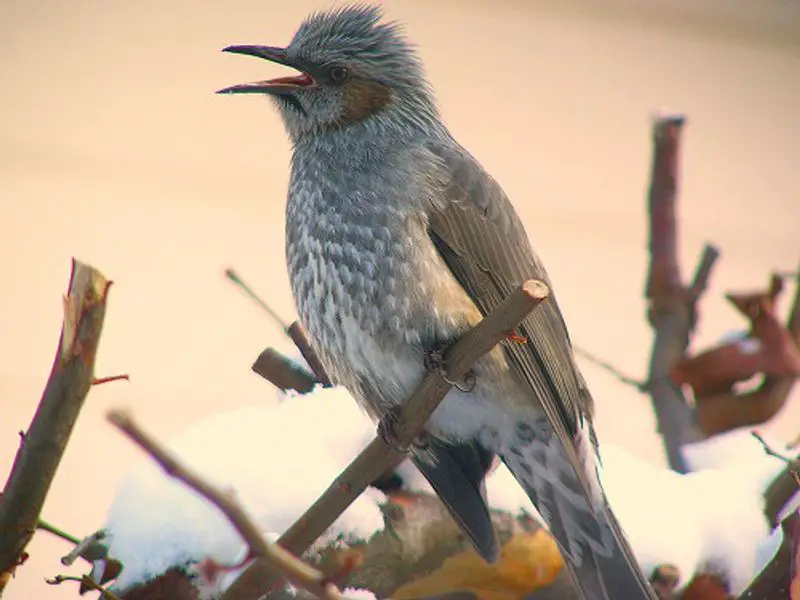
The bulbuls are a type of songbird, belonging to the family Pycnonotidae. This family is made up of a variety of birds, including greenbuls, Brownbuls, leafloves, and bristlebills. These birds are all of medium size, and they can be found across a wide geographical range.
They are native to most of Africa and extend into the Middle East, tropical Asia, and even as far as Japan. The bulbuls are a common sight in warmer climates, and their cheerful songs make them popular among birders.
They are usually found in wooded areas, but can sometimes be seen in urban areas as well. They make their nests in trees and feed mainly on fruits, insects, and small animals.
| Kingdom | Animalia |
| Phylum | Chordata |
| Class | Aves |
| Order | Passeriformes |
| Family | Pycnonotidae |
36. Bearded Vulture
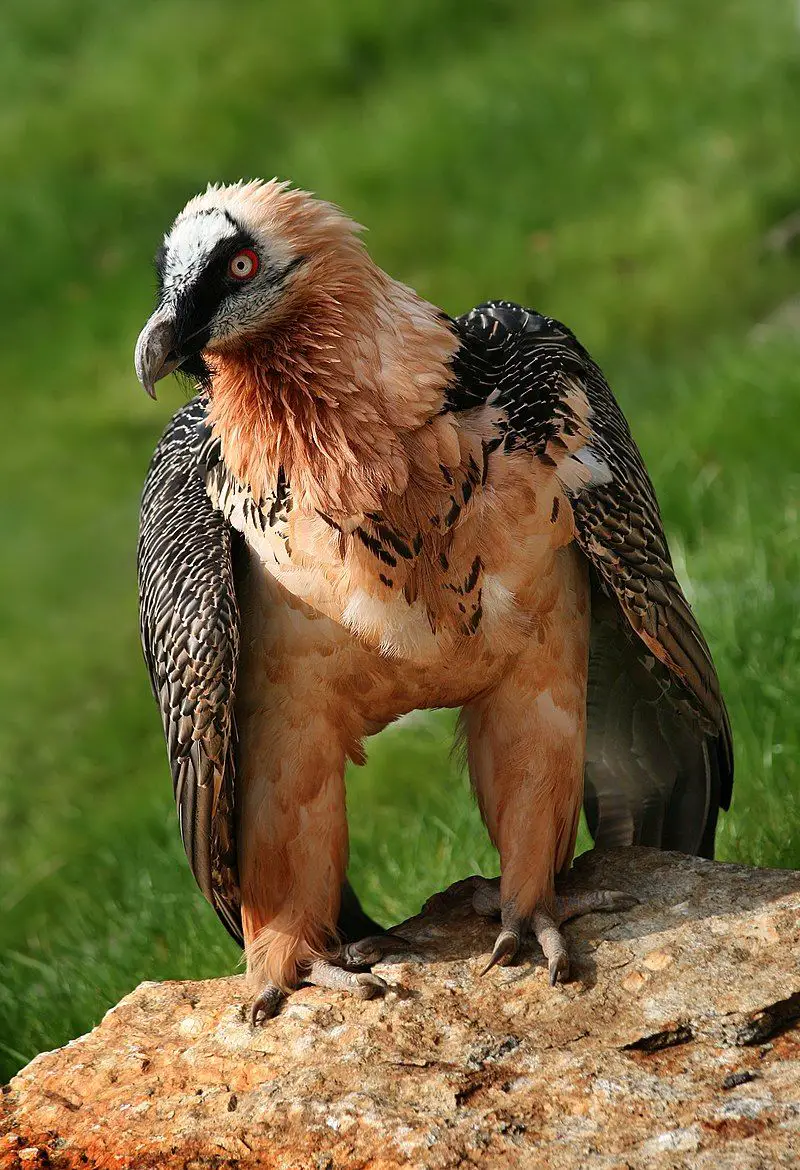
The bearded vulture is a very large bird of prey and is the only bird of its genus, Gypaetus. It is also known as the lammergeier and ossifrage. This bird is a part of the Accipitridae family and is closely related to the Egyptian vulture.
Though traditionally considered an Old World vulture, it has its own distinct lineage within the family. Bearded vultures are very large birds, with wingspans reaching up to 8.2 feet.
They have distinctive feathery ruffs on their neck and throat, which vary in color from white to brown. These birds are scavengers and feed mainly on the bones of livestock and wild animals. They use their powerful beaks to break open bones and access the marrow inside.
Bearded vultures are found in parts of Europe, Asia, and Africa, typically in mountainous and rocky areas. They are usually solitary but can be found in pairs or small groups during the breeding season.
These birds lay one to three eggs in a nest constructed from sticks and twigs, and both parents take turns incubating the eggs. The bearded vulture is an important species in the ecosystem, helping to break down the carcasses of dead animals.
However, their population is declining due to human activities such as habitat destruction and illegal hunting. Conservation efforts are underway to protect the species and its habitat.
| Kingdom | Animalia |
| Phylum | Chordata |
| Class | Aves |
| Order | Accipitriformes |
| Family | Accipitridae |
| Genus | Gypaetus |
| Species | G. barbatus |
37. Blue Whistling Thrush
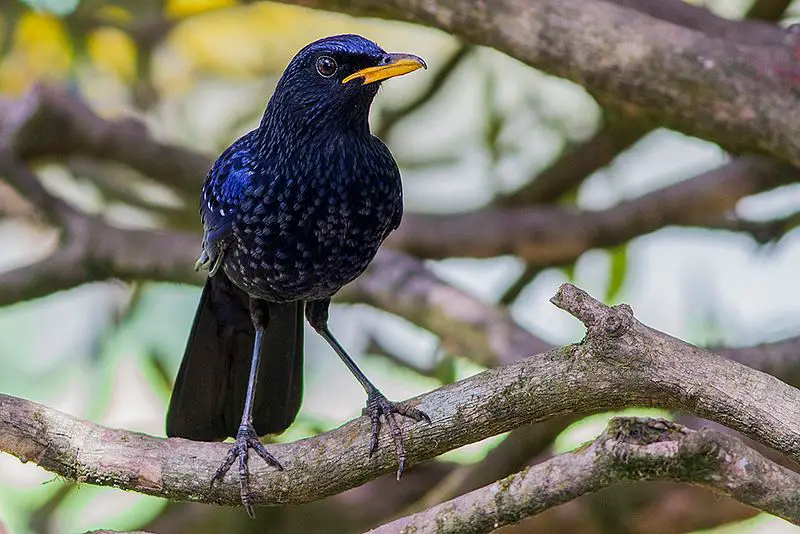
The blue whistling thrush is a bird found in the mountains of Central Asia, South Asia, China, and Southeast Asia. It is part of the Old World flycatchers family Muscicapidae and is distinguished by its distinctive blue plumage.
The bird is most well-known for its loud, human-like whistling song which can be heard at dawn and dusk. This song is usually composed of three distinct notes that are repeated in a steady rhythm.
The blue whistling thrush is also known for its impressive vocal abilities, which include mimicry and a variety of other calls. The bird’s song is thought to be a form of communication between individuals, as well as a territorial display.
Additionally, the blue whistling thrush’s song is believed to serve as a signal to predators, warning them of its presence. The blue whistling thrush is an important species in its native range as it helps to maintain the delicate balance of nature.
Its diet consists mainly of insects and small invertebrates, which it helps to keep in check. Furthermore, its bright plumage adds a splash of color to the otherwise muted mountain scenery.
The blue whistling thrush is a treasured species, both for its beauty and its melodious song.
| Kingdom | Animalia |
| Phylum | Chordata |
| Class | Aves |
| Order | Passeriformes |
| Family | Muscicapidae |
| Genus | Myophonus |
| Species | M. caeruleus |
38. Tibetan Snowcock
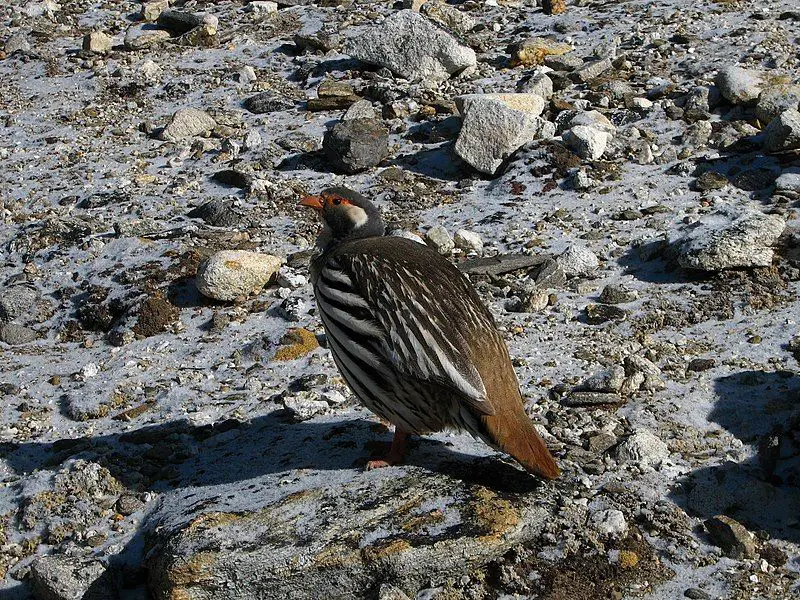
The Tibetan snowcock is a species of bird in the Phasianidae family, which is part of the order Galliformes, a group of large, ground-dwelling birds.
This species lives in high-altitude regions of the Western Himalayas and the Tibetan Plateau, and its range overlaps with that of the larger Himalayan snowcock. The Tibetan snowcock is usually found in rocky areas, where it feeds on a variety of plants, insects, and lizards.
It is known for its impressive climbing abilities and for its ability to survive in the harsh environment of its mountainous habitat. The Tibetan snowcock is a fairly large bird, with a body length of up to 40 centimeters, and its feathers are a grey-brown color.
It is an important species for the conservation of the Himalayan ecosystem, as it helps to maintain the balance of the environment.
| Kingdom | Animalia |
| Phylum | Chordata |
| Class | Aves |
| Order | Galliformes |
| Family | Phasianidae |
| Genus | Tetraogallus |
| Species | T. tibetanus |
39. Laughingthrushes
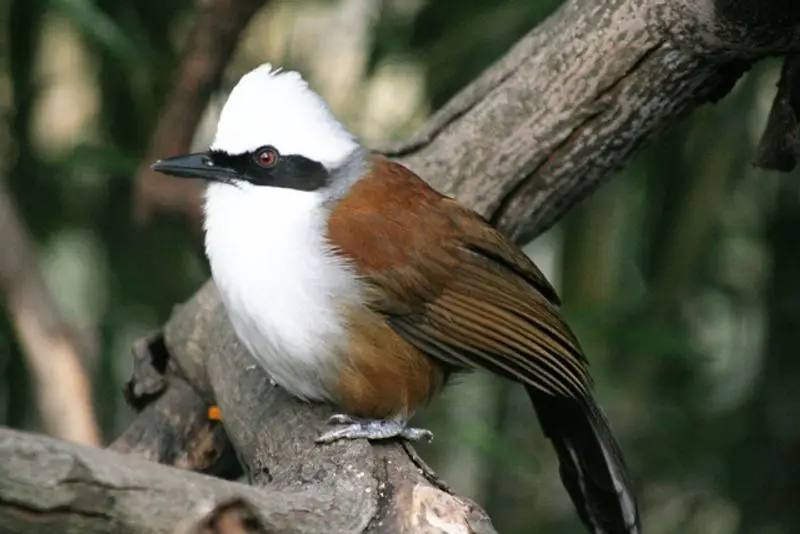
The laughingthrushes are a family of Old World passerine birds, belonging to the family Leiothrichidae. These birds are found mainly in tropical areas, with the greatest variety being present in Southeast Asia and the Indian subcontinent.
They vary greatly in size, color, and overall appearance. In the past, the laughingthrushes were grouped with the Timaliidae family. This family is known as the Old World babblers and includes a wide variety of different species of birds.
The laughingthrushes have since been separated into their own family due to their distinct physical characteristics and behavior. The laughingthrushes are a lively and sociable family of birds.
They typically live in large flocks and communicate with each other through their distinctive call.
These birds are also known for their intelligence, as they are able to learn and mimic different sounds. Overall, the laughingthrushes are a fascinating family of birds that are found mainly in tropical regions.
They can vary greatly in size and coloration and are known for their lively and sociable behavior. They were once grouped with the Old World babblers, but have since been separated into their own families due to their unique characteristics.
| Kingdom | Animalia |
| Phylum | Chordata |
| Class | Aves |
| Order | Passeriformes |
| Family | Leiothrichidae |
40. Kalij Pheasant
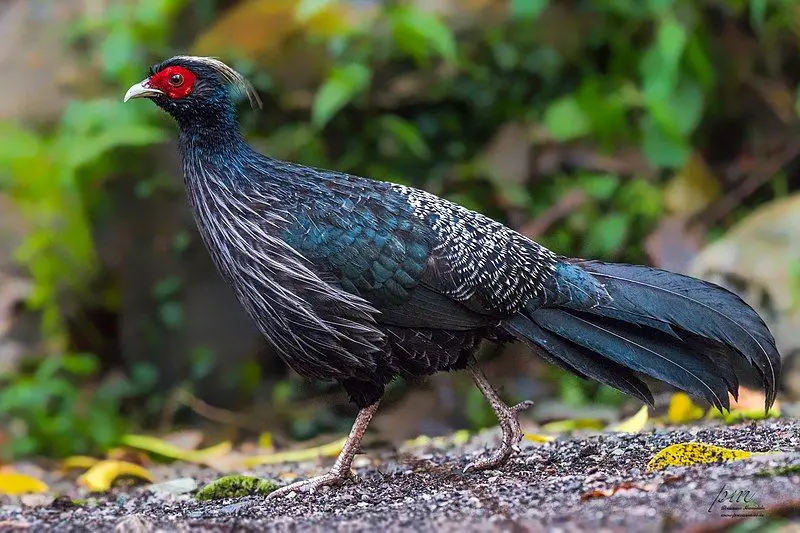
The kalij pheasant is a gorgeous bird found in lush forests and thickets across the Himalayan foothills, ranging from Nepal, and Pakistan to western Thailand. These birds come in a range of sizes and colors, depending on the subspecies involved.
The males typically have a glossy blue-black plumage, while the females are usually a more muted brown. The males are usually much more eye-catching, with their bright colors and long tails, while the females are more subdued in their overall appearance.
The Kalij pheasant is a popular game bird, with hunters often targeting the males for their bright feathers. The females are hunted less often but still provide a great challenge for any hunter.
The Kalij pheasant is a beautiful species and a popular hunting target, with its range spanning across the Himalayan foothills.
| Kingdom | Animalia |
| Phylum | Chordata |
| Class | Aves |
| Order | Galliformes |
| Family | Phasianidae |
| Genus | Lophura |
| Species | L. leucomelanos |
41. Yellow-billed Blue Magpie
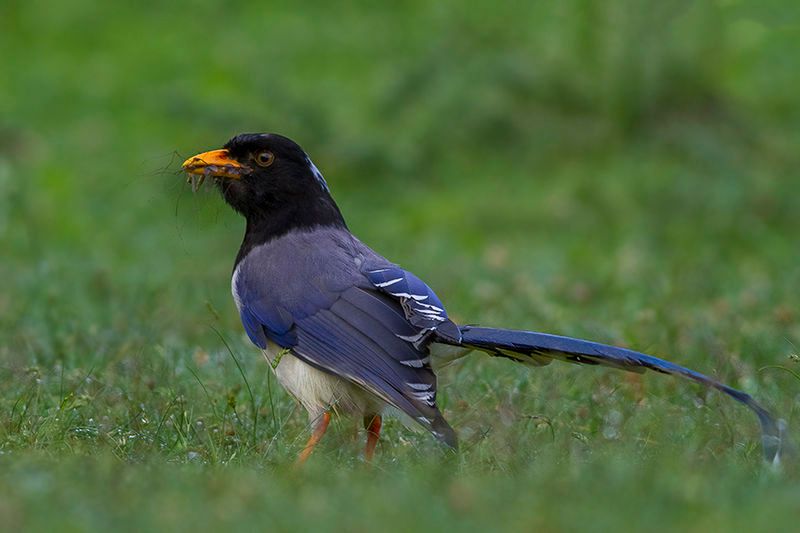
The yellow-billed blue magpie is a species of bird that belongs to the crow and jay family, Corvidae. It is characterized by its striking blue and yellow plumage, making it a very distinctive species.
It has a long, thin yellow beak, and its wings are a mix of blue, yellow, and white.
It is found in East and Southeast Asia, from India to the eastern coast of China. The yellow-billed blue magpie is closely related to two other species of bird, the Taiwan blue magpie and the red-billed blue magpie.
Together, these three species form a superspecies, meaning that they are very similar in terms of their genetic makeup, behavior, and habitat preferences.
The yellow-billed blue magpie is the most widespread of the three, living in a variety of habitats from forests to open grasslands, but all three species prefer to stay in areas with lots of trees and shrubs.
The yellow-billed blue magpie is an omnivore, meaning that it will eat both plant and animal matter. Its diet consists of a variety of items including fruits, nuts, seeds, insects, and small vertebrates such as lizards and mice.
It is a social species, often seen in flocks of up to 30 individuals. It is territorial and will defend its nest and food sources from other birds. The yellow-billed blue magpie is an important species in many cultures, often being considered a symbol of luck or prosperity.
It is also a popular pet in some countries and is often kept as a companion bird. While its populations are declining due to habitat destruction and poaching, it is still considered a fairly common species.
| Kingdom | Animalia |
| Phylum | Chordata |
| Class | Aves |
| Order | Passeriformes |
| Family | Corvidae |
| Genus | Urocissa |
| Species | U. flavirostris |
42. Blue-throated Barbet
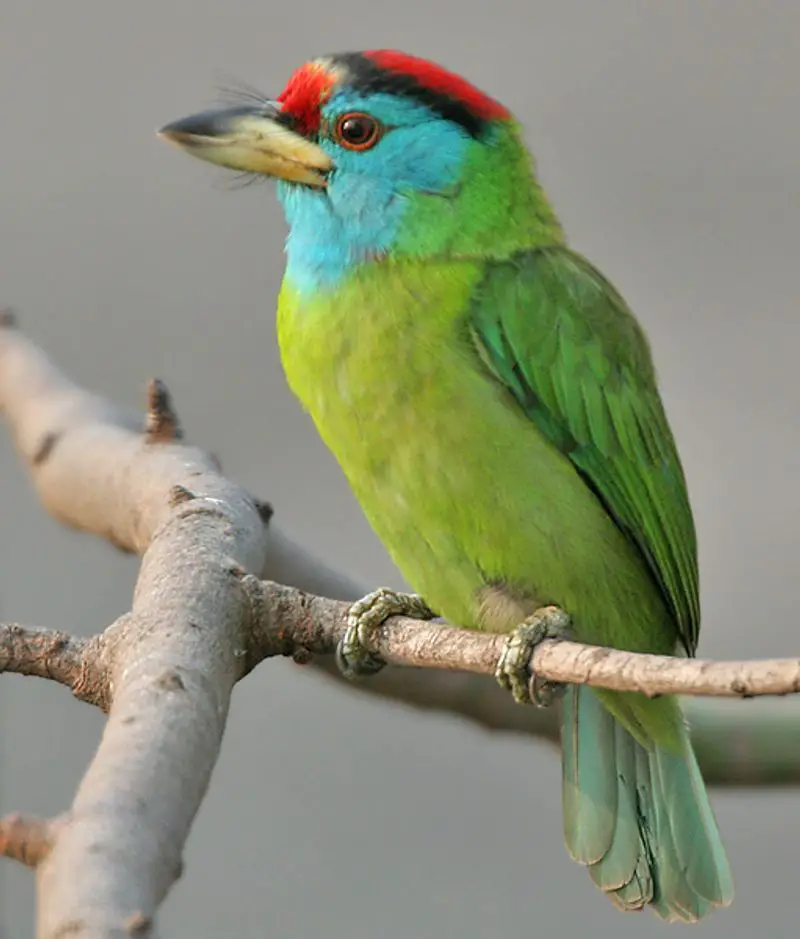
The blue-throated barbet is an exotic bird found in the Asian continent. It is native to the Himalayan foothills and Southeast Asia and can be spotted in lowland and montane forests, typically at elevations of 200-2000 m.
It is known for its vibrant plumage, with hues of bright green, blue, and red tones. The barbet is mostly found in pairs or small family groups, as they are known to be quite social creatures. They are quite territorial and will often defend their turf from other barbet species.
Their diet consists mainly of fruits and seeds, which they find in their natural habitat. With its stunning colors and captivating behavior, the blue-throated barbet is an impressive sight for any nature enthusiast.
| Kingdom | Animalia |
| Phylum | Chordata |
| Class | Aves |
| Order | Piciformes |
| Family | Megalaimidae |
| Genus | Psilopogon |
| Species | P. asiaticus |
43. Satyr Tragopan
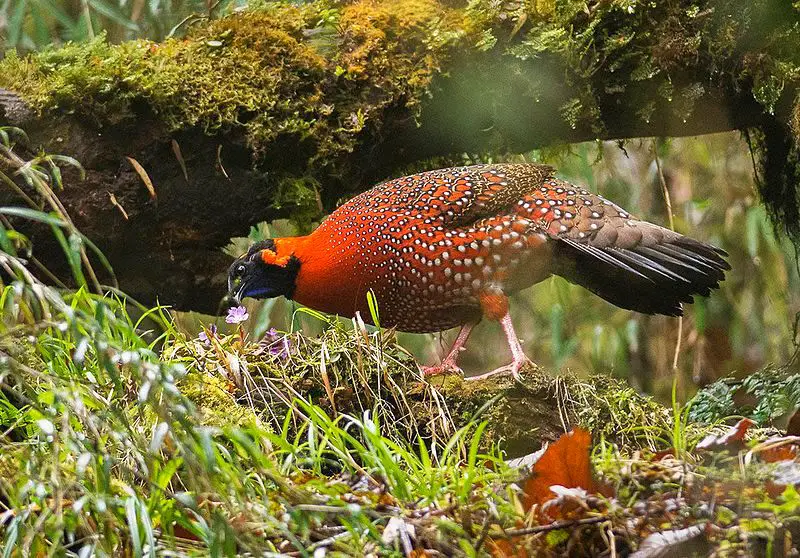
The satyr tragopan is a unique and beautiful bird species found in the Himalayan region of India, Tibet, Nepal, and Bhutan. It is also known as the crimson-horned pheasant due to its bright crimson and yellow coloration.
This species of pheasant prefers to inhabit moist oak and rhododendron forests with dense undergrowth and clumps of bamboo. They are considered to be an altitude-adapted species, meaning that they can survive in a variety of altitudes.
In summer, they can be found up to 4200 meters high and in winter they can be found as low as 1800 meters. This species of pheasant is also known to exhibit a unique courtship display which includes fanning out their feathers and making loud calls.
This behaviour is believed to be used to attract a mate and to ward off potential predators. The satyr tragopan is a beautiful and unique species of bird, and its presence in the Himalayan region is an important part of the region’s biodiversity.
| Kingdom | Animalia |
| Phylum | Chordata |
| Class | Aves |
| Order | Galliformes |
| Family | Phasianidae |
| Genus | Tragopan |
| Species | T. satyra |
44. Fire-tailed Sunbird
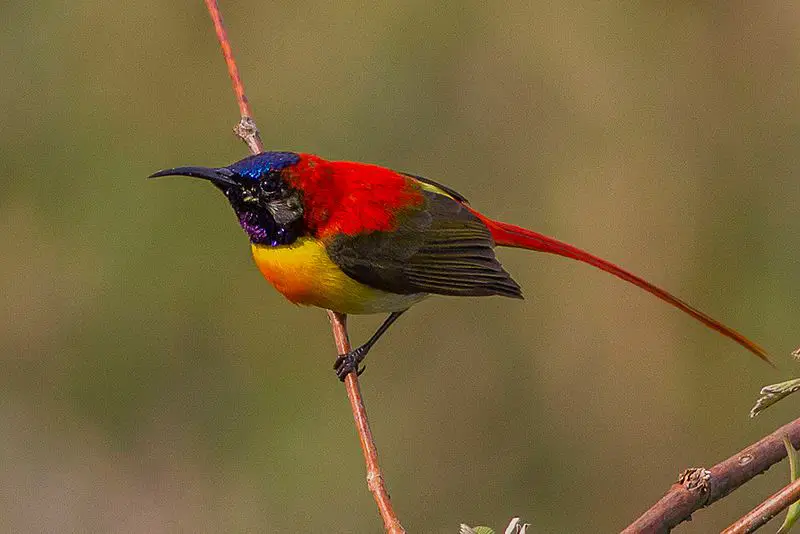
The Fire-tailed Sunbird is a species of sunbird found in the northern parts of the Indian subcontinent, primarily in the Himalayas and some adjoining regions in Southeast Asia. This species is present in Bangladesh, Bhutan, India, Myanmar, Nepal, Thailand and Tibet.
The Fire-tailed Sunbird is a member of the Nectariniidae family and is a small bird with a bright, red tail. It has a black throat and chest, along with bright yellow and white patches on its wings.
Its head and back are a brownish-olive color, while its underparts are a yellowish-white. It has a long, thin bill and long legs which help it to feed on nectar from flowers. The Fire-tailed Sunbird is a social species and is usually seen in pairs or small groups.
It feeds mainly on nectar and small insects, and its diet also includes some fruit. It is a territorial species and can often be heard singing loudly in the early morning.
The Fire-tailed Sunbird builds its nest from plant matter and feathers and is usually placed in a tree or shrub. It will also occasionally use a hole in a wall or a tree trunk for nesting.
The Fire-tailed Sunbird is a species of conservation concern due to habitat loss and degradation. It is listed as Vulnerable by the International Union for Conservation of Nature (IUCN).
Conservation efforts to protect this species include habitat protection and restoration, as well as monitoring of populations.
| Kingdom | Animalia |
| Phylum | Chordata |
| Class | Aves |
| Order | Passeriformes |
| Family | Nectariniidae |
| Genus | Aethopyga |
| Species | A. ignicauda |
45. Chestnut-bellied Rock Thrush
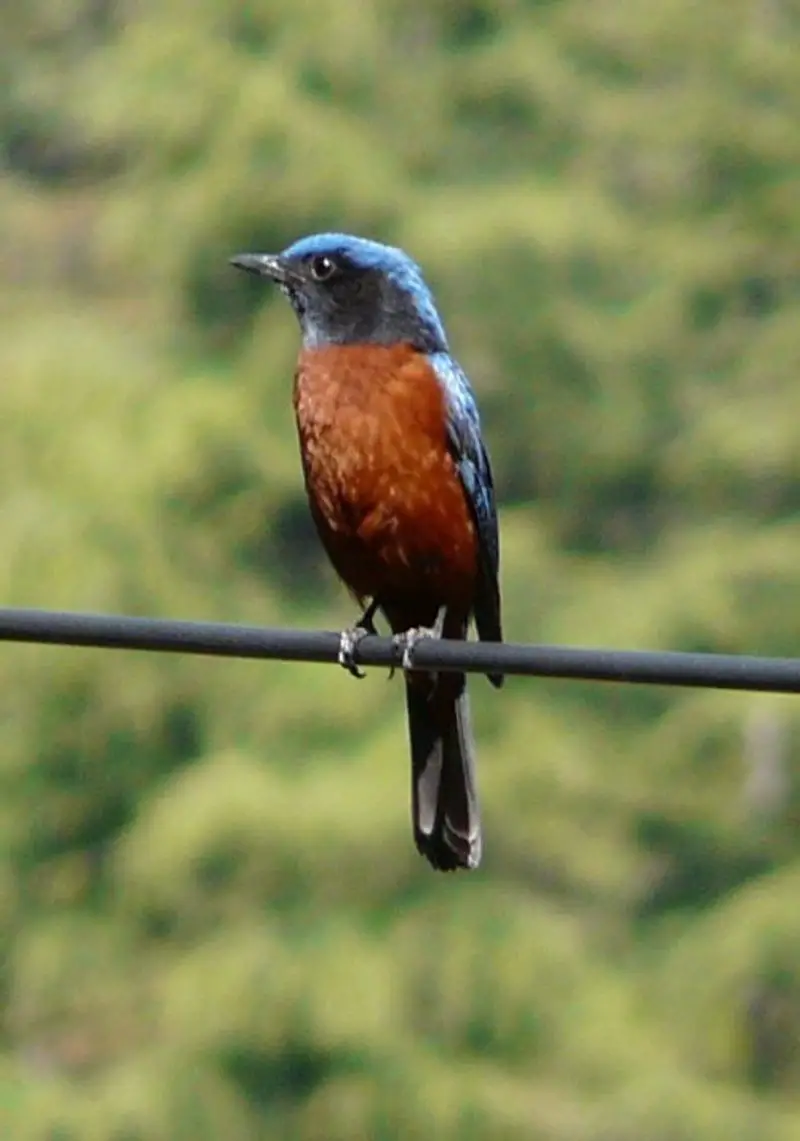
The Chestnut-bellied Rock Thrush is a species of bird belonging to the family Muscicapidae. It is a medium-sized bird, measuring around 16 cm in length. It is known for its reddish-brown chestnut-bellied plumage and black head.
This species is found mainly in the northern regions of the Indian subcontinent, across East Asia, and parts of Southeast Asia. Its range extends from Bangladesh, Bhutan, India, and Tibet, to Laos, Myanmar, Nepal, Pakistan, Thailand, and Vietnam.
It prefers habitats such as rocky areas, cliffs, and ravines, which provide it with plenty of food and shelter. The Chestnut-bellied Rock Thrush is an omnivore, meaning it feeds on both plants and animals. Its diet includes insects, small lizards, berries, and other fruits.
The species is not considered to be globally threatened, however, it is listed as vulnerable in some parts of its range. Its population is declining due to habitat loss and fragmentation.
Conservation efforts are being made to ensure the survival of this species, including the protection of its natural habitat.
| Kingdom | Animalia |
| Phylum | Chordata |
| Class | Aves |
| Order | Passeriformes |
| Family | Muscicapidae |
| Genus | Monticola |
| Species | M. rufiventris |
46. Little Forktail
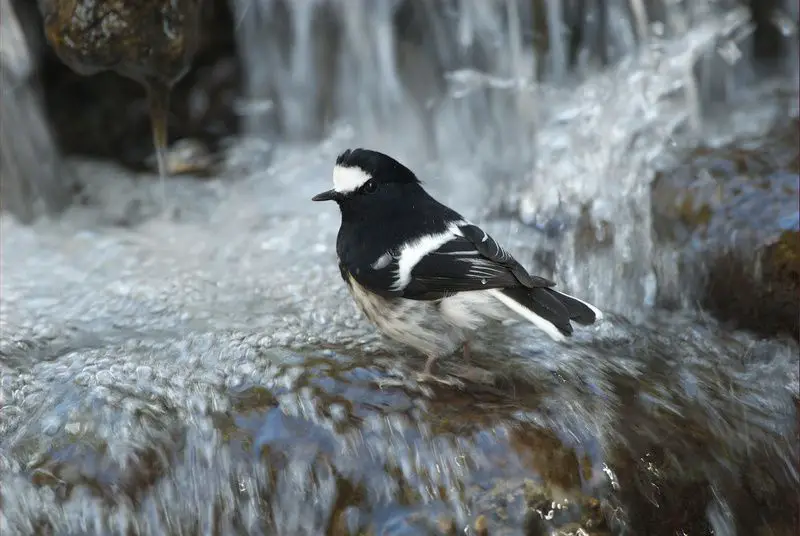
The little forktail is a species of bird belonging to the Muscicapidae family. This species is distinguished by its unique tail which forks at the end. It is native to various parts of Asia, including India, China, and Indonesia.
The specific name of this bird is a tribute to the Scottish naturalist Dr John Scouler of Glasgow. Dr Scouler was one of the first naturalists to document and study the species in detail. He was an avid bird watcher and was known for his passion for the study of birds.
Dr. Scouler’s work on the little forktail helped to further the understanding of the species and its behavior. His dedication and commitment to the study of birds is commemorated in the species’ specific name.
| Kingdom | Animalia |
| Phylum | Chordata |
| Class | Aves |
| Order | Passeriformes |
| Family | Muscicapidae |
| Genus | Enicurus |
| Species | E. scouleri |
47. White-crested Laughingthrush
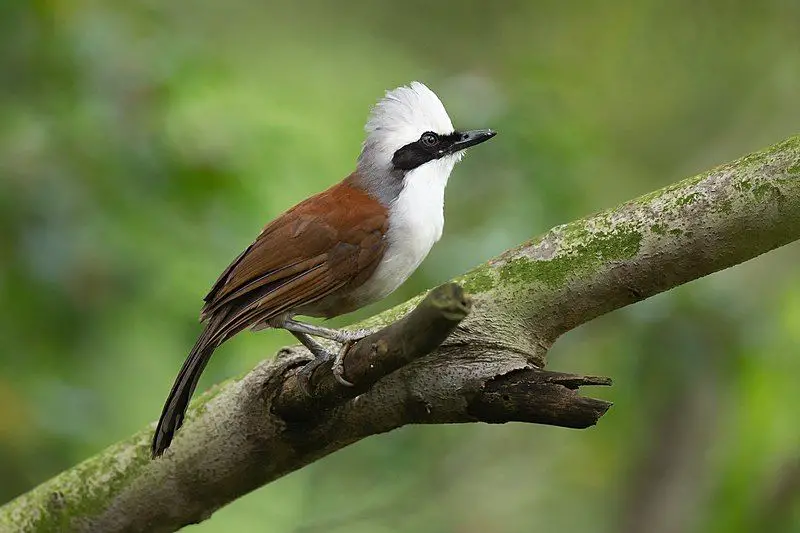
The white-crested laughingthrush is an impressive and social bird. It belongs to the Leiothrichidae family, which is known for its vocal and expressive members.
The white-crested laughingthrush is no exception and can be found in a variety of habitats, from forest to scrub to the Himalayan foothills to Southeast Asia. There, it is a very social species and is known for its vocalizations, which are loud and melodic.
Its white crest adds to its beauty, making it a unique sight to behold. The white-crested laughing thrush is an interesting species that adds diversity to the habitats it inhabits.
| Kingdom | Animalia |
| Phylum | Chordata |
| Class | Aves |
| Order | Passeriformes |
| Family | Leiothrichidae |
| Genus | Garrulax |
| Species | G. leucolophus |
48. Crested Kingfisher
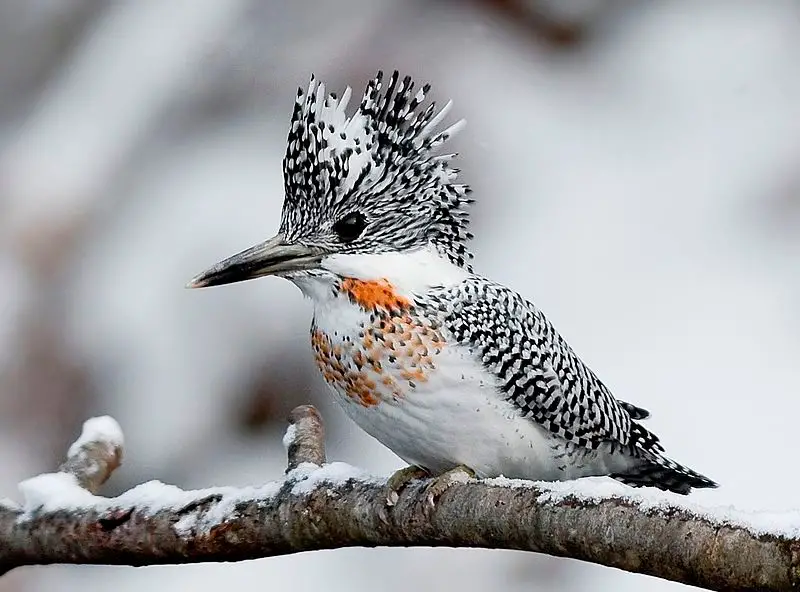
The crested kingfisher is a species of kingfisher that is native to parts of southern Asia, an area stretching eastwards from the Indian Subcontinent to Japan. It is a large species of kingfisher and forms a species complex with the other three Megaceryle species.
This species complex is defined by a group of closely related species that are morphologically similar.
The crested kingfisher is one of the more widespread species in the complex, being found in southern India, Sri Lanka, Bangladesh, Myanmar, Thailand, Laos, Cambodia, Vietnam, China, Taiwan, South Korea, and Japan.
It is a medium-sized kingfisher, measuring between 28-32 cm in length, with a wingspan of between 42-47 cm. It has distinctive blue and white plumage, and a long, pointed bill.
Its diet consists mainly of fish, frogs, insects, and crustaceans, which it hunts from a perch near a body of water. It is usually found in open or semi-open habitats such as grasslands, coastal wetlands, and mangrove swamps.
The crested kingfisher is considered to be of least concern on the IUCN Red List of Threatened Species.
| Kingdom | Animalia |
| Phylum | Chordata |
| Class | Aves |
| Order | Coraciiformes |
| Family | Alcedinidae |
| Genus | Megaceryle |
| Species | M. lugubris |
49. Black-necked Crane
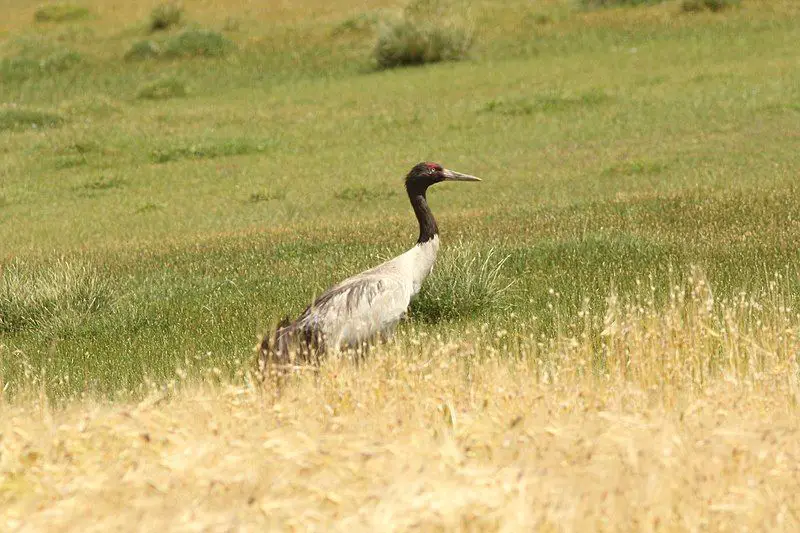
The black-necked crane is a majestic bird that is native to parts of Asia. It is a medium-sized crane, measuring 139 cm in length with a wingspan of 235 cm and weighing 5.5 kg. This crane is a striking sight, with a white-gray body and a black head, neck, and legs.
On the head, there is a distinctive red crown patch and a white patch behind the eye. This crane breeds mainly on the Tibetan Plateau, as well as in remote parts of India and Bhutan.
It has adapted to the cold temperatures of these areas, and it can be seen in the highland meadows and wetlands that make up its habitat.
The black-necked crane is a migratory species, and it can be seen in East Asia throughout the year. The crane feeds on plant matter, such as grasses and grains, as well as small insects and fish.
It is a social species, and it can often be seen in large flocks, although it usually breeds in pairs.
The crane is also known for its spectacular courtship dances, which are composed of leaps and bows. The black-necked crane is an important species in the region, and it is protected in many parts of its range.
Unfortunately, it is threatened by habitat destruction, hunting, and pollution. Conservation efforts are in place to protect this species and ensure that it can survive for many generations to come.
| Kingdom | Animalia |
| Phylum | Chordata |
| Class | Aves |
| Order | Gruiformes |
| Family | Gruidae |
| Genus | Grus |
| Species | G. nigricollis |
Conclusion
The Himalayas are home to a wide variety of birds, including species that are found nowhere else in the world. This unique and diverse range of birds is an integral part of the Himalayan ecosystem and provides a wealth of benefits to the region.
These birds are essential for maintaining the delicate balance of nature in the mountains and must be protected and conserved for future generations.